Crafting Adirondack chairs? Wondering which wood reigns supreme? Delve into our top selections and build the perfect chair for ultimate outdoor relaxation!
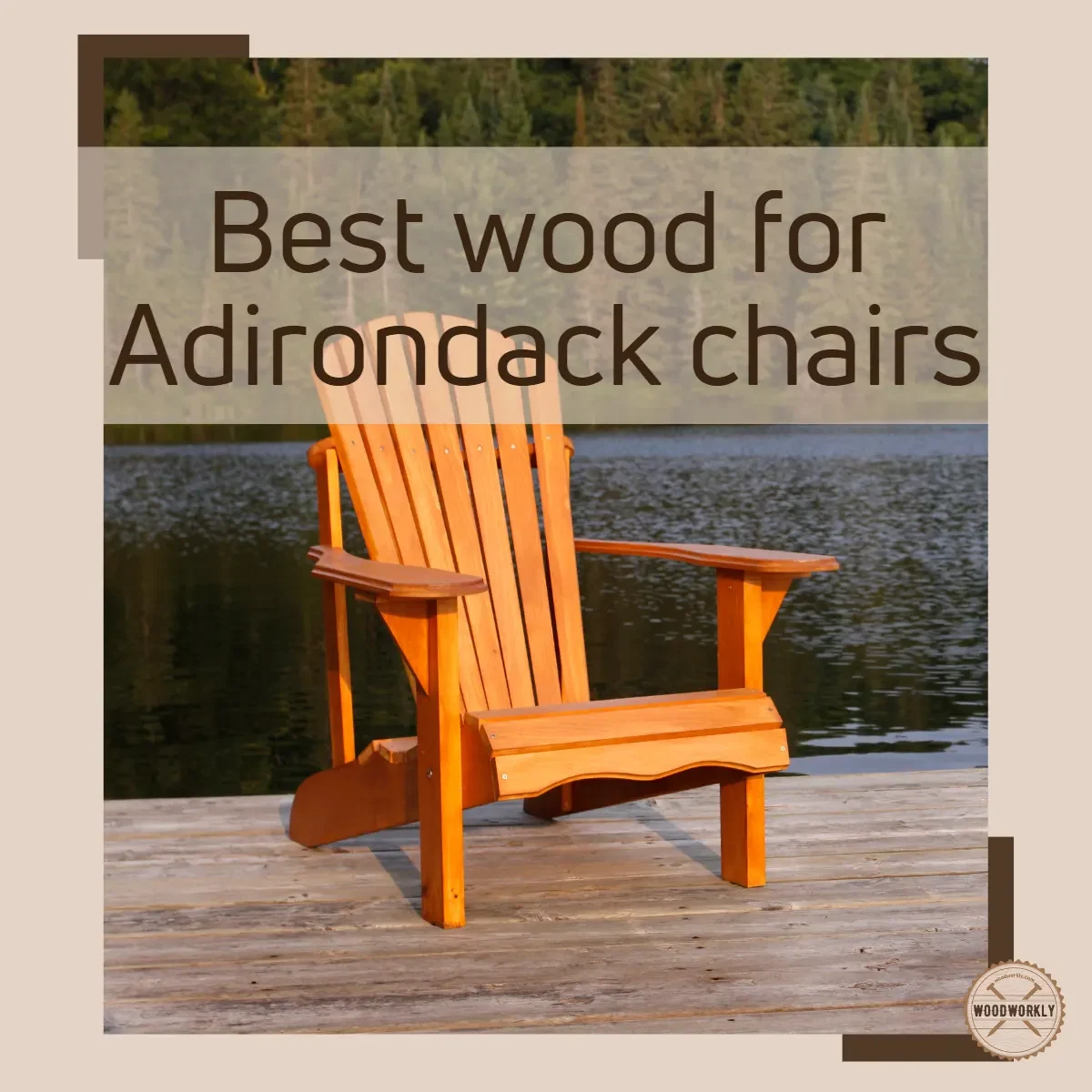
Are you tired of sifting through countless articles to find the ultimate wood for your Adirondack chair? Search no more!
In a world of ever-changing trends, one thing remains constant: our love for cozy, stylish Adirondack chairs.
But, with a plethora of wood choices at your fingertips, how do you decide which one reigns supreme? Fear not, for we’ve taken the guesswork out of your hands.
Here’re the best wood for Adirondack chairs,
- Red cedar wood
- Mahogany
- White oak
- Yellow pine
- Teak
- Ipe or Brazilian walnut
- Red oak
- Cypress
- Douglas fir
- Eucalyptus
- Acacia
- Alder
- Aspen
- Maple
- Pressure-treated wood
In this mind-bending yet enlightening blog post, we unravel the enigma that is the ideal wood for your Adirondack throne by describing each of the best wood for Adirondack chairs.

We dive into the heart of sustainability, durability, and style, all wrapped up in a single, mesmerizing package.
Furthermore, I’ll answer some frequently asked questions as well.
Prepare to embark on a thrilling journey, unveiling the perfect fusion of form and function for your outdoor haven.
Join us, and let’s craft an Adirondack masterpiece together!
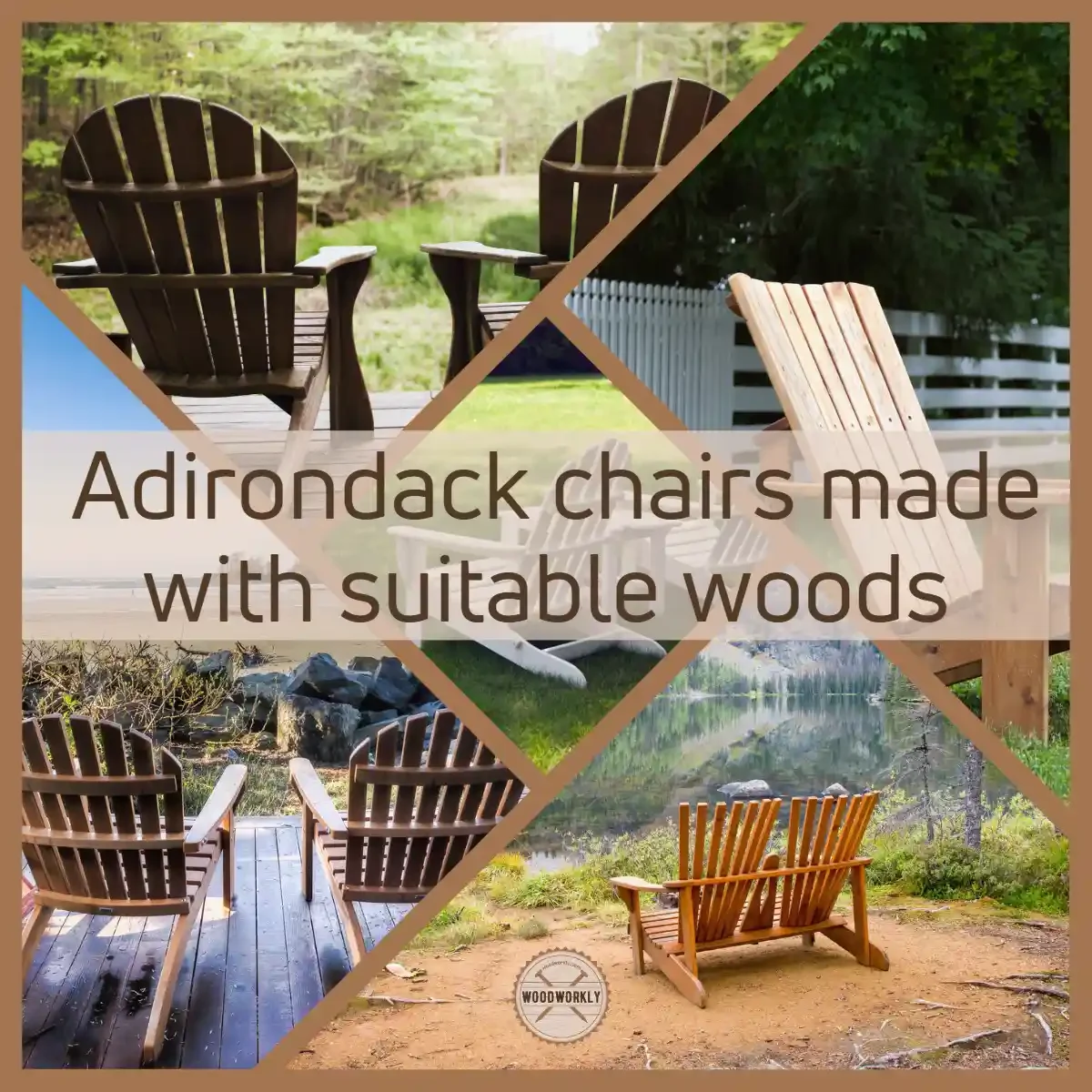
Before the journey begins, let’s see what are the things you should concern when selecting the right wood for your Adirondack chairs.
Factors To Consider When Choosing Wood For Adirondack Chairs
Nowadays, Adirondack chairs make with lots of different materials such as wood, plastic, aluminum, high-density polyethylene (HDPE), leather, and nylon.
But wood is the best material to make Adirondack chairs due to its excellent durability and aesthetic.
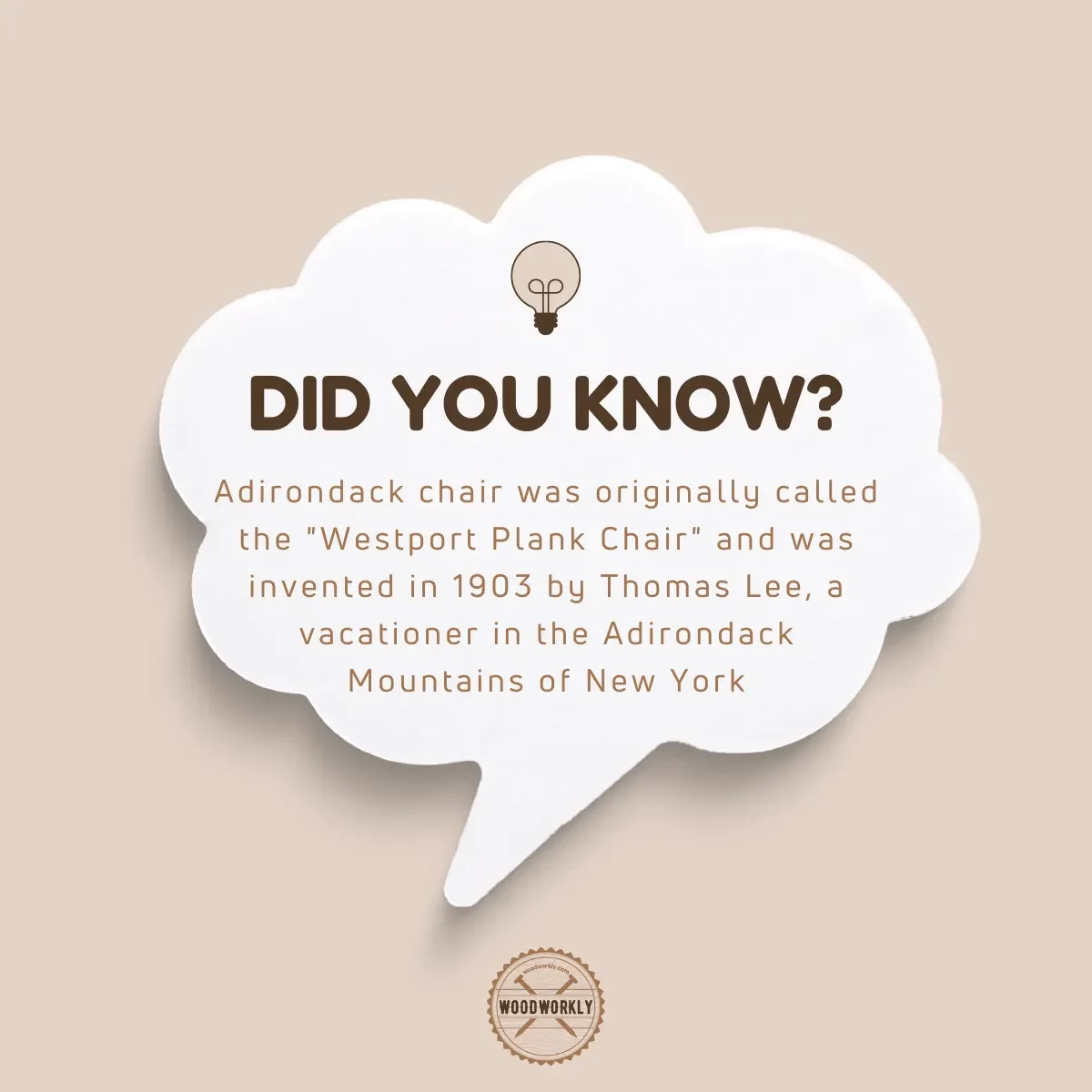
I’ve had my fair share of encounters with various types of wood, each bringing its unique charm to the table.
Here’re some of the key factors you should consider when choosing the right wood for Adirondack chairs,
- Durability And Strength
- Decay and insect resistance
- Workability
- Maintenance
- Aesthetics
- Budget
- Sustainability
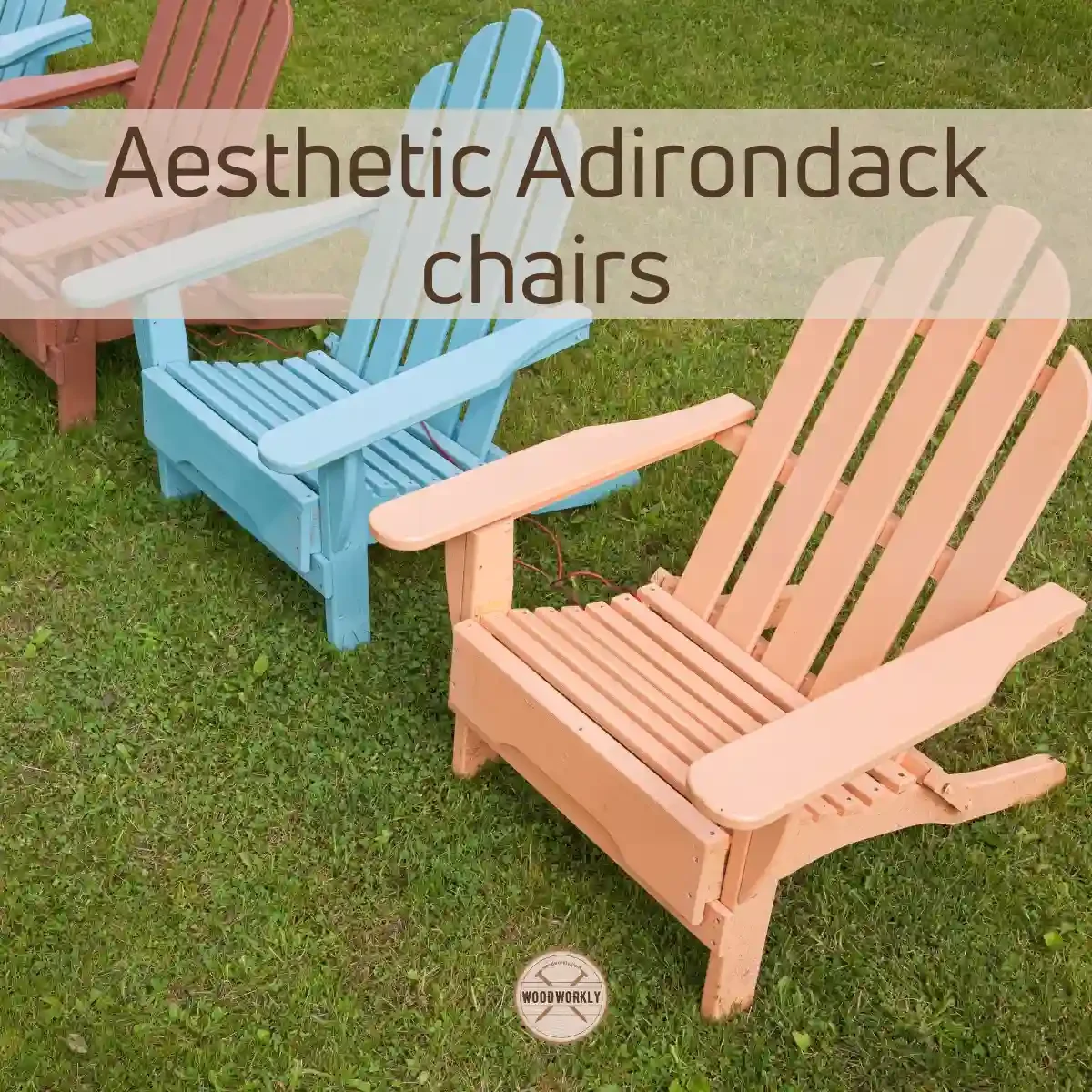
When you’re selecting wood for Adirondack chairs, make sure to focus especially on the above factors to select the most suitable one according to your preferences.
Because there’re some woods which are not suitable to make Adirondack chairs, they are non-durable and don’t have good resistance to weather elements which is an essential thing when it comes to an outdoor project like making Adirondack chairs.
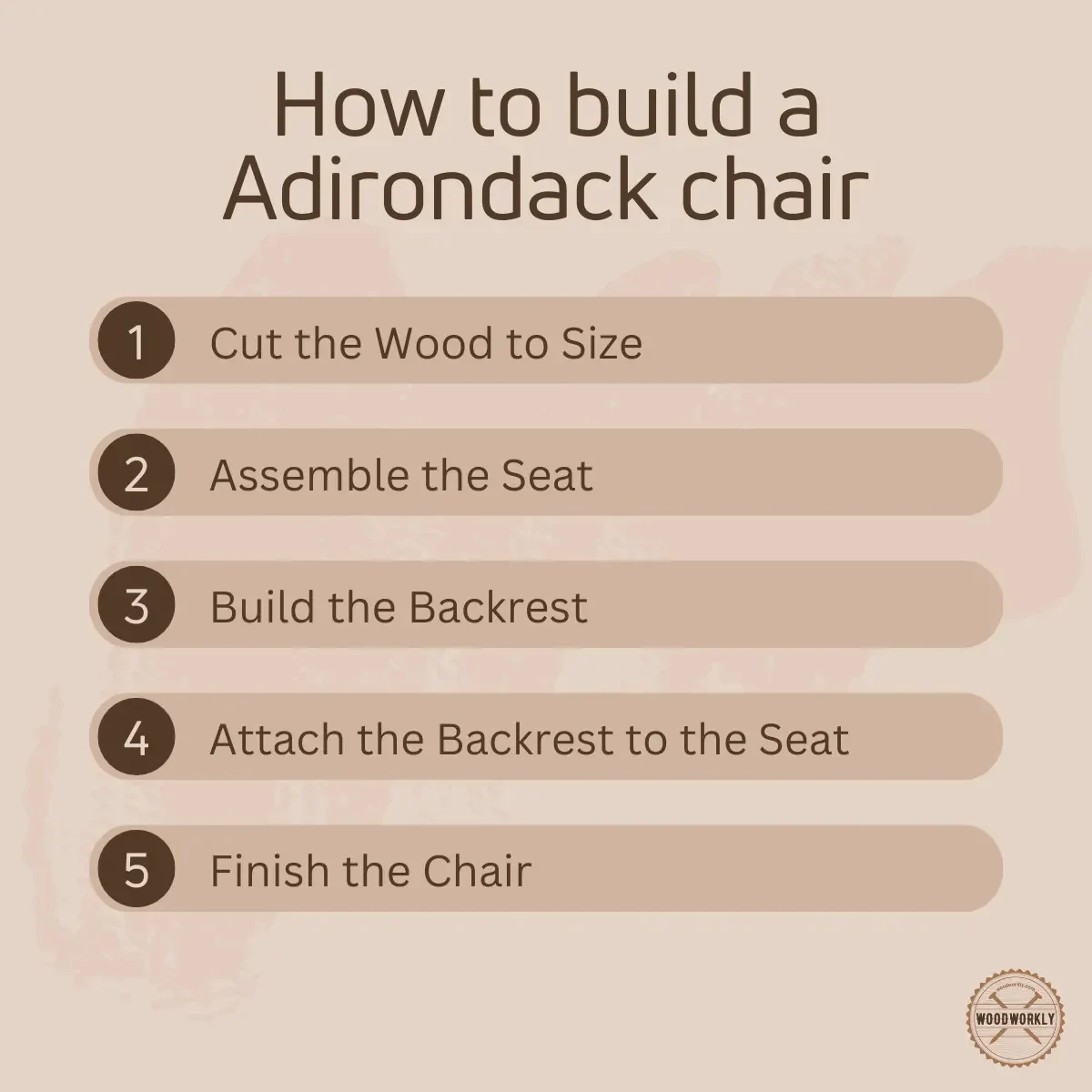
Let’s discuss each of the above things that should consider when selecting the right Adirondack chairs in detail to get a better understanding of the woods.
1. Durability And Strength
Wood that you’re going to use for making Adirondack chairs should have good durability to withstand weather elements like high humidity, moisture, insect attacks, UV light, and many more.
In the outdoors, Adirondack chairs’ surface will get contact with lots of extreme weather conditions like rain, snow, and high-temperature levels.
So, make sure to select wood that is able to withstand environmental impact with excellent strength and durability to keep your Adirondack chairs for a long time with zero issues.
A wood’s ability to withstand wear, pressure, and damage is vital for a long-lasting Adirondack chair.
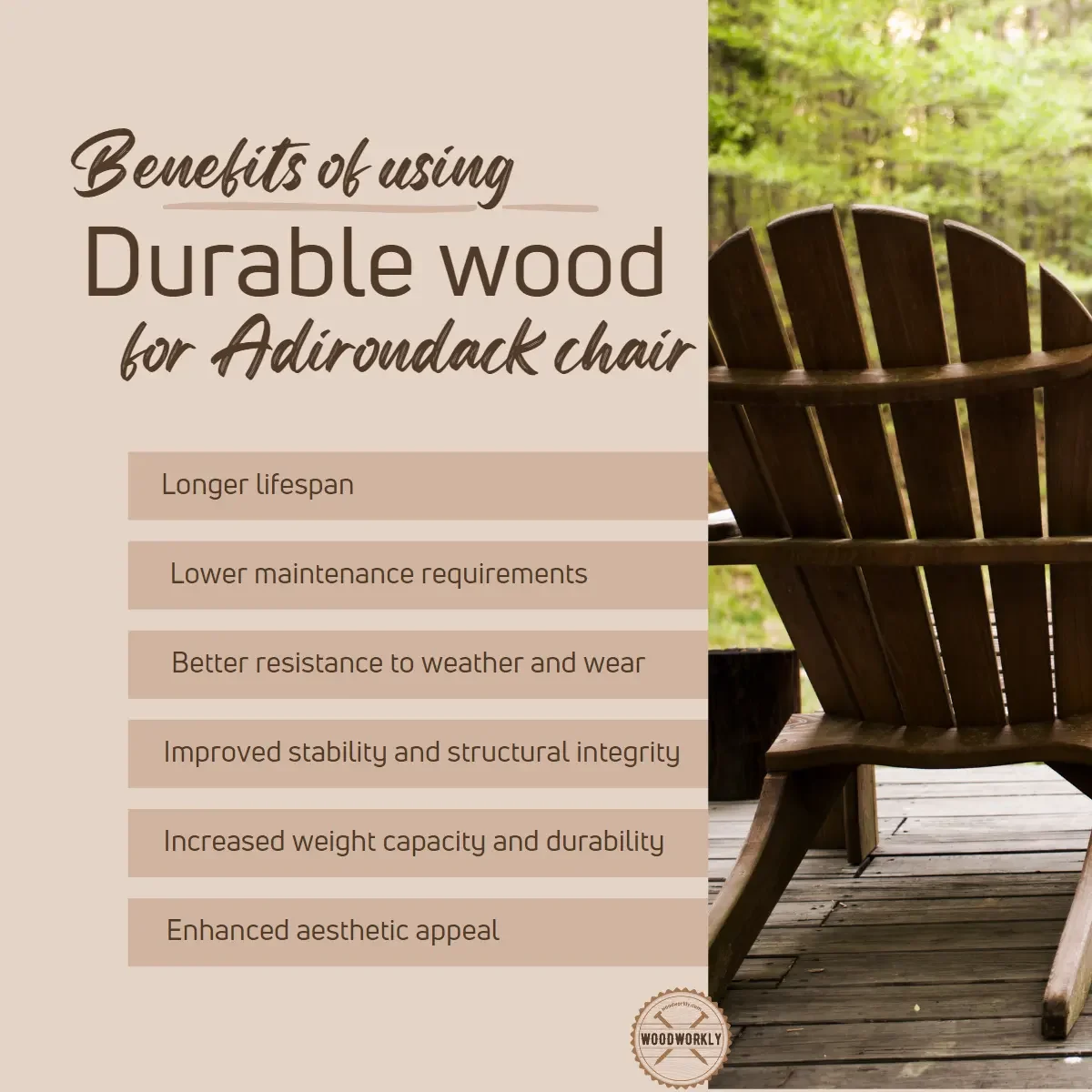
Strong wood can support more weight, resist warping or cracking, and maintain its structural integrity for years.
Seek dense, sturdy species that can survive the test of time and the elements, providing you with a reliable and comfortable seating option.
2. Decay And Insect Resistance
Adirondack chairs should have good resistance against moisture to keep from rot and decay.
Plus, the wood should have the insect-repellent ability or should finish with a good finish that makes bugs and pests hate the wood is a must to avoid insect attacks.
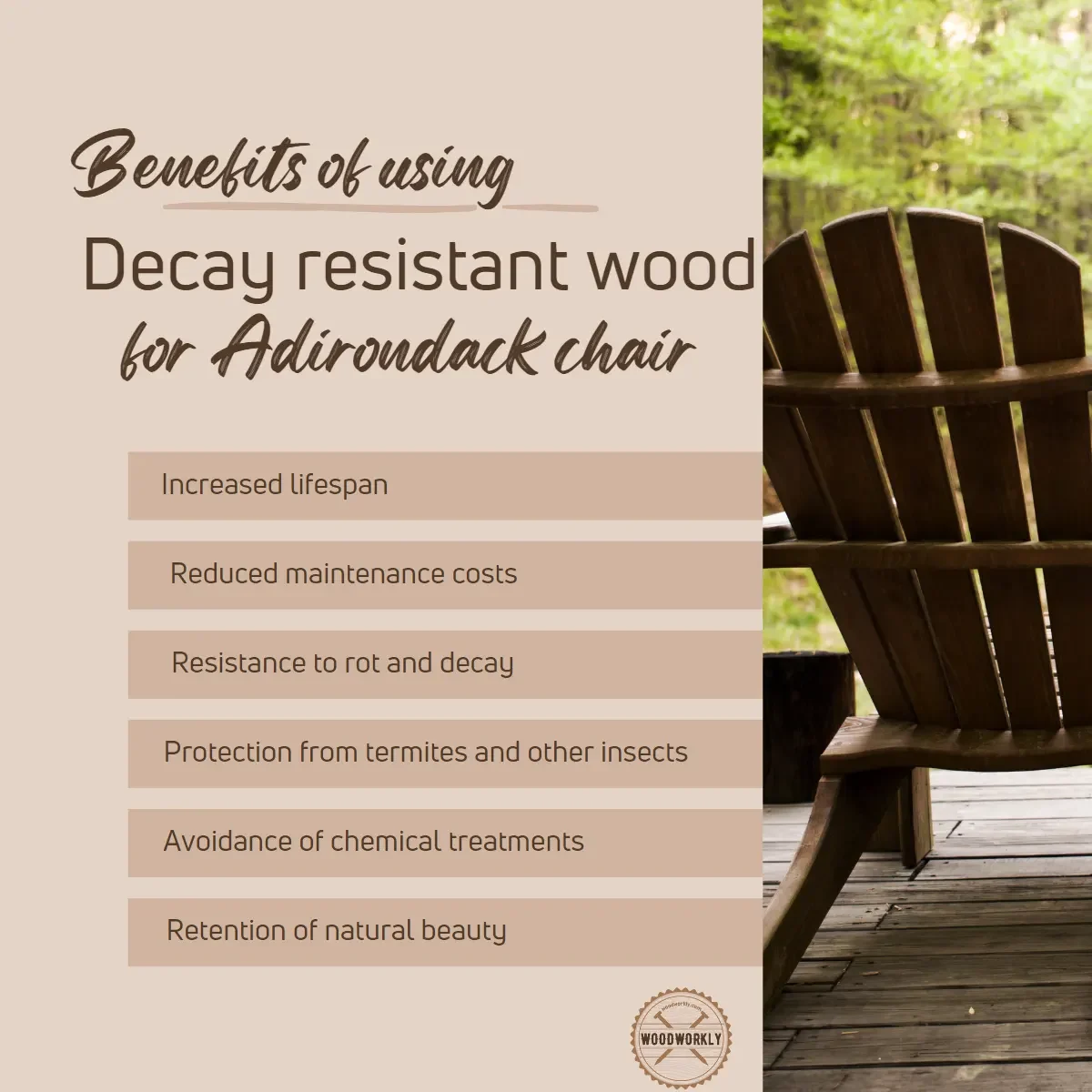
Certain wood species possess natural oils and chemicals that deter insects and prevent decay, prolonging your chair’s lifespan.
With decay and insect-resistant wood, you’ll spend less time worrying about damage and more time enjoying your outdoor retreat.
Consider woods like cedar, teak, or redwood, known for their inherent resistance to these common wood adversaries.
3. Workability
Adirondack wood should be easy to work even for beginners. As Adirondack chair enthusiasts, you should select a wood that is easy to work with even with woodworking hand tools to enjoy your work.
Some woods are more forgiving when it comes to cutting, shaping, and joining.
Therefore, select wood that is easy to cut, nail, screw, and shape and without peeling or chipping the wood.
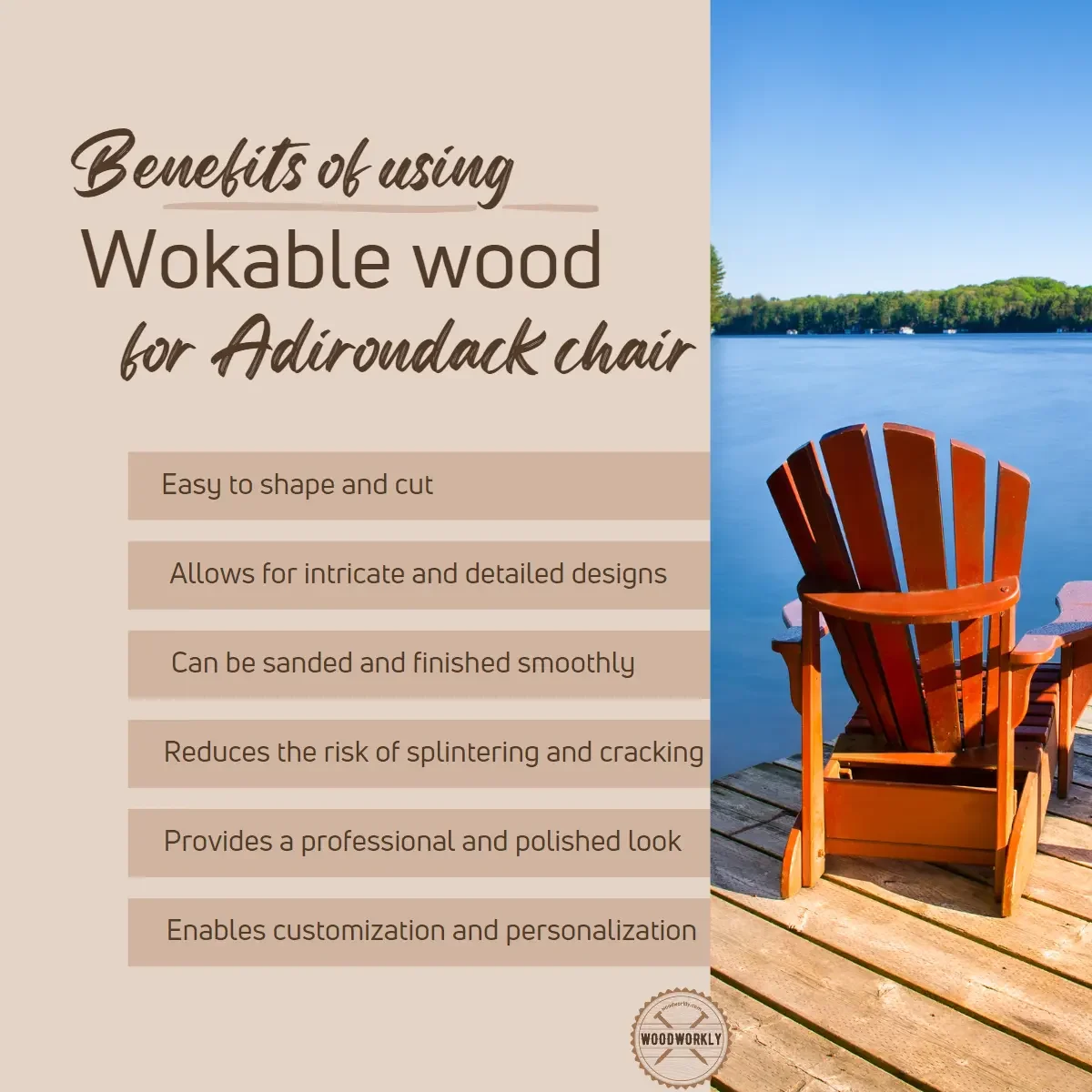
As a woodworker, it’s essential to find wood that can be easily worked with hand tools or machinery, without excessive splintering, tearing, or blunting your tools.
A wood that’s pleasant to work with will save time, energy, and frustration during the construction of your Adirondack chair.
4. Maintenance
Adirondack chair wood should be easy to clean and maintain. If the maintenance is super hard, you’ll ignore the maintenance work of your Adirondack chair over time, and the chair will get damaged and ruined over time.
Therefore, select a wood that is easy to clean, refinish with a good finish, and keeps its sheen for a long time even with little maintenance.
The upkeep required to keep your Adirondack chair in tip-top shape is an essential factor.
Low-maintenance wood species may need less frequent staining, sealing, or cleaning, leaving you more time to enjoy your outdoor space.

Consider the climate you live in and the exposure to sun, rain, or snow, as these factors may impact your chair’s maintenance requirements.
5. Aesthetics
The attractiveness of the wood is a key factor when it comes to making an outdoor project like Adirondack chairs.
If the wood has a beautiful texture and grain pattern with a highlighting wood color, your affection and love for the woodwork will increase.

Consider wood species that offer rich hues, intricate grain patterns, and unique textures, adding character and elegance to your outdoor space.
The perfect wood will not only provide comfort and durability but also enhance the beauty of your surroundings.
6. Budget
How much money you should spend on Adirondack chair material is a key factor you should concern about. Sometimes you can get the same performance from cheaper woods rather than spending a lot on expensive luxurious wood types.
Please note that quality wood doesn’t have to be prohibitively expensive.
Explore options that offer a balance between durability, aesthetics, and affordability.

By finding a wood that meets your budget constraints without sacrificing quality, you’ll create a long-lasting Adirondack chair that is both a functional and cost-effective addition to your outdoor area.
7. Sustainability
As a woodworker, you have a responsibility to protect the environment while taking wood to make woodwork and furniture.
Therefore, always go for sustainable wood sources when selecting wood for the Adirondack chairs.
Look for woods harvested from responsibly managed forests or rapidly renewable species like eucalyptus.
By choosing sustainable materials, you’re actively contributing to global conservation efforts, ensuring that future generations can also enjoy the beauty and comfort of Adirondack chairs.
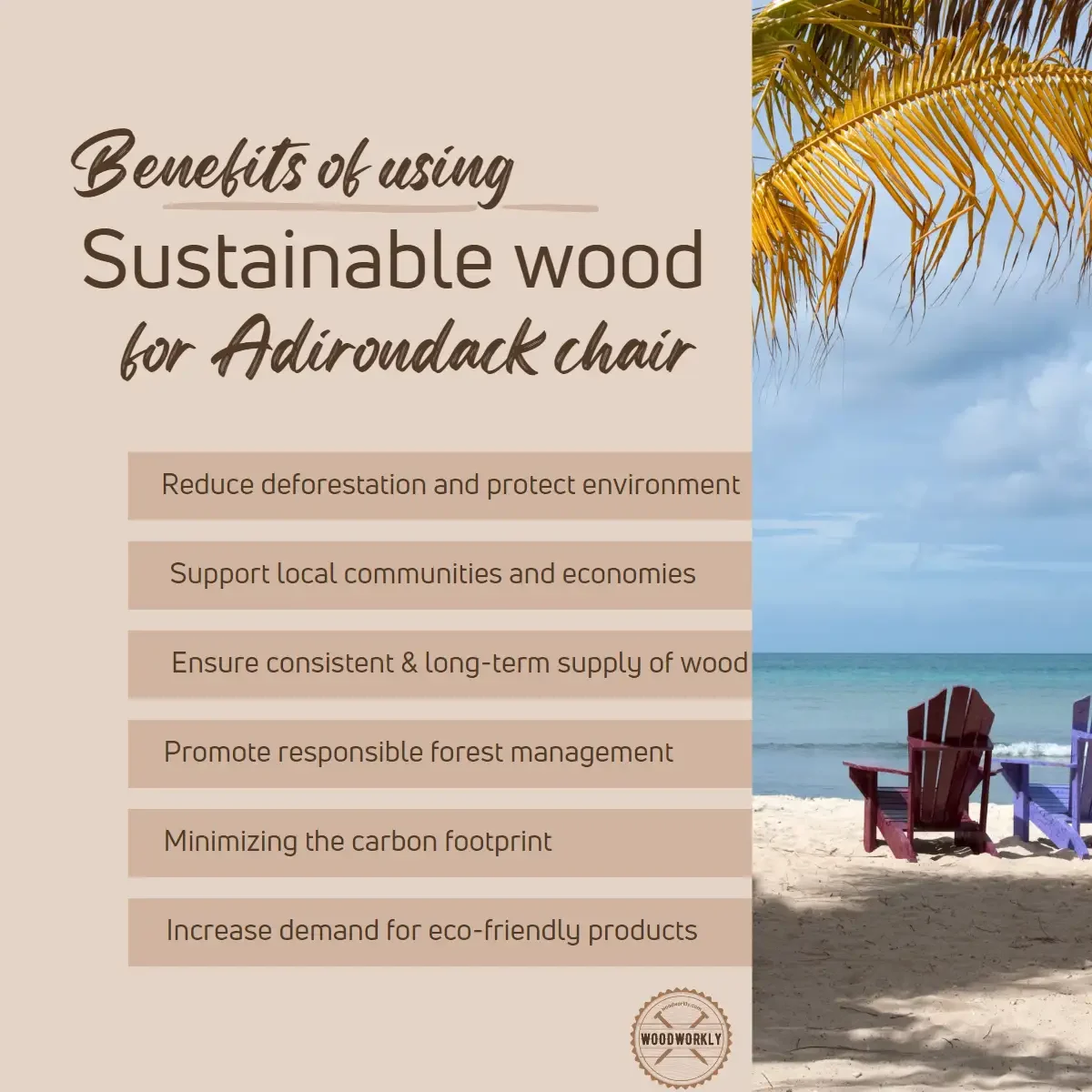
Enough chit chats!
So, let’s head into the favorite section of discussing the best wood for Adirondack chairs in detail.
Best Wood For Adirondack Chairs
1. Red Cedar Wood
Red cedar is an excellent wood for making Adirondack chairs since it has rot and decay resistance. Plus, red cedar contains and releases natural oil that repels bugs and insects.
Plus, red cedar can withstand humid and extreme weather with no issues. Therefore, it has become one of the best wood for Adirondack chairs.
Red Cedar – a woodworker’s delight and a true gem for crafting Adirondack chairs.
With a captivating reddish hue that mellows into a silvery gray over time, Red Cedar’s alluring appearance is but a prelude to its charm.
Sporting a straight grain and uniform texture, this wood’s beauty lies in its innate elegance.
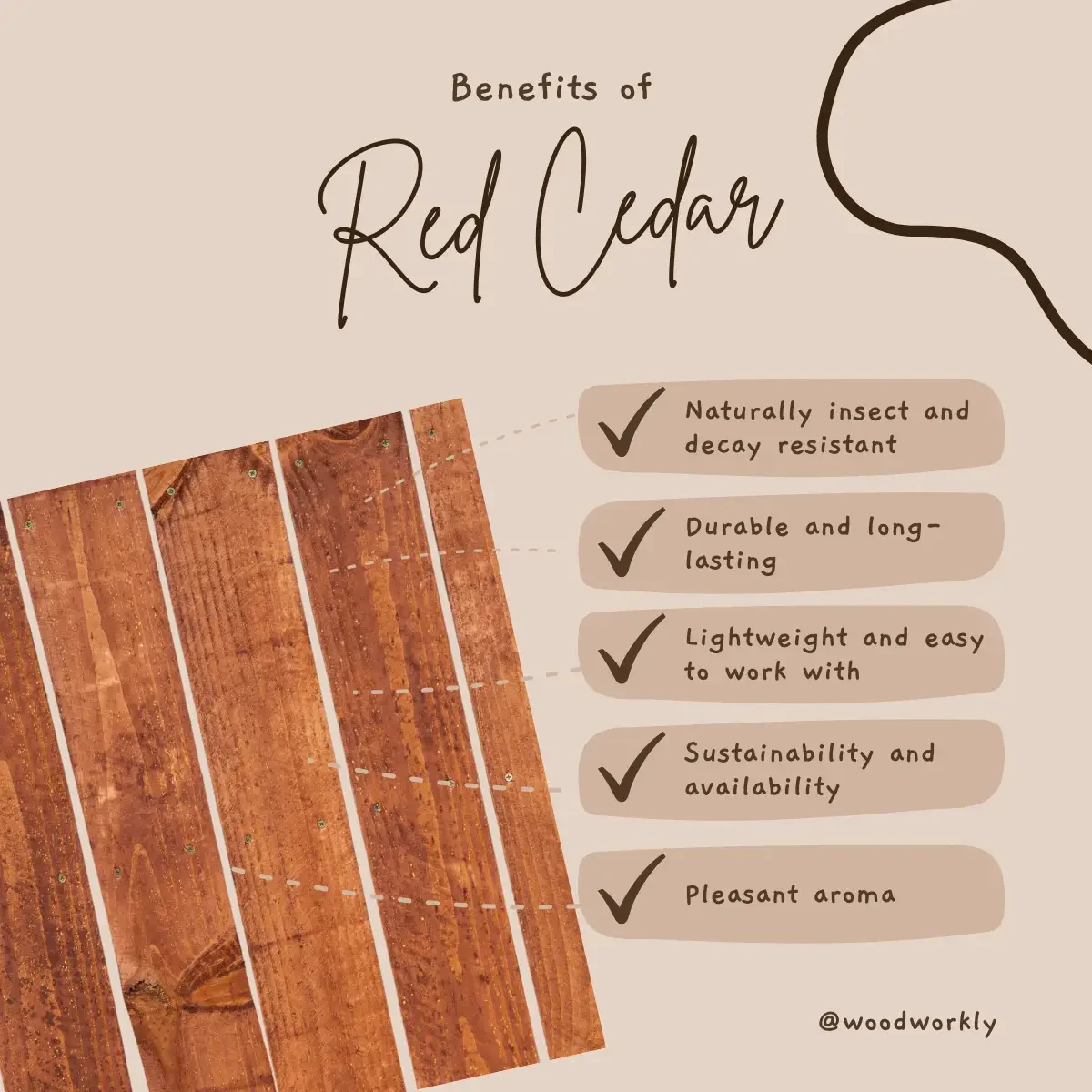
Why, you ask, is Red Cedar a top contender for Adirondack chairs?
Here’re the qualities that make Red Cedar great for Adirondack chairs,
Durability & Strength
Red Cedar’s formidable resilience extends beyond its resistance to warping and splitting.
This wood’s strength-to-weight ratio is impressive, making it sturdy without being overly heavy – a perfect balance for a comfortable yet steadfast Adirondack chair.
Decay & Insect Resistance
The natural oils within Red Cedar not only ward off decay and insects but also imbue the wood with a delightful aroma.
As a result, your Adirondack chair remains not just unblemished, but also pleasantly fragrant, contributing to a serene outdoor atmosphere.
Workability
Red Cedar’s cooperative nature extends to its compatibility with various finishes and stains.
The wood’s ability to take paint and stains well enhances your chair’s visual appeal and offers you the flexibility to customize your chair’s appearance to your liking.

Maintenance
Thanks to Red Cedar’s low-maintenance character, any dirt or mildew that accumulates over time can be easily removed with a simple soap and water solution.
With minimal effort, your Adirondack chair will continue to shine as the star of your outdoor space.
Aesthetics
The allure of Red Cedar’s visual charm evolves over time.
As the wood ages, its reddish hue gracefully transitions to a silvery gray patina, adding a touch of rustic elegance to your Adirondack chair and blending harmoniously with your outdoor setting.
Sustainability
Red Cedar’s rapid growth rate and responsible harvesting practices ensure that forests can replenish themselves, preserving the wood’s availability for future generations.
By choosing Red Cedar, you’re not only crafting a stunning Adirondack chair but also supporting sustainable forestry.
In summary, Red Cedar’s mesmerizing looks, hardy nature, and eco-friendly roots make it a prime candidate for your Adirondack chair.
Crafted from this wood, your chair is destined to be a delightful fusion of form and function, a beacon of relaxation that withstands the test of time.

Advantages and Disadvantages Of Using Red Cedar For Adirondack Chairs
| Advantages | Disadvantages |
| Naturally resistant to decay, insects, and moisture | May be more expensive compared to other wood options |
| Lightweight and easy to work with | Requires regular maintenance for optimal appearance |
| Aromatic scent deters pests | Color can fade over time if not properly protected |
| Attractive reddish-brown color and straight grain pattern | Softwood, making it more prone to dents and scratches |
2. Mahogany
Mahogany is a strong and durable hardwood that is great for making Adirondack chairs. Mahogany can withstand extreme weather and it is easy to stain and finish.
Therefore, your Adirondack chair made with Mahogany will last for so long with no issues.

Here’re some characteristic qualities of Mahogany that make it great for Adirondack chairs,
Durability & Strength
Mahogany is known for its excellent durability and strength. It belongs to the luxurious wood types which are great for Adirondack chairs.
Mahogany’s density lends it impressive resistance to dents and scratches, ensuring your Adirondack chair remains immaculate despite daily wear and tear.
This wood’s dimensional stability prevents it from warping or twisting, preserving your chair’s structural integrity.
Decay & Insect Resistance
Mahogany’s natural resistance to rot and insects are enhanced by its low porosity, which prevents water absorption and further guards your Adirondack chair against moisture-related damage.
These qualities enable your chair to withstand harsh outdoor conditions and maintain its allure.
Workability
Mahogany’s cooperative nature extends to its compatibility with a variety of woodworking tools and techniques, including carving, turning, and bending.
This versatility allows you to customize your Adirondack chair with intricate details or unique shapes, elevating its aesthetic appeal.
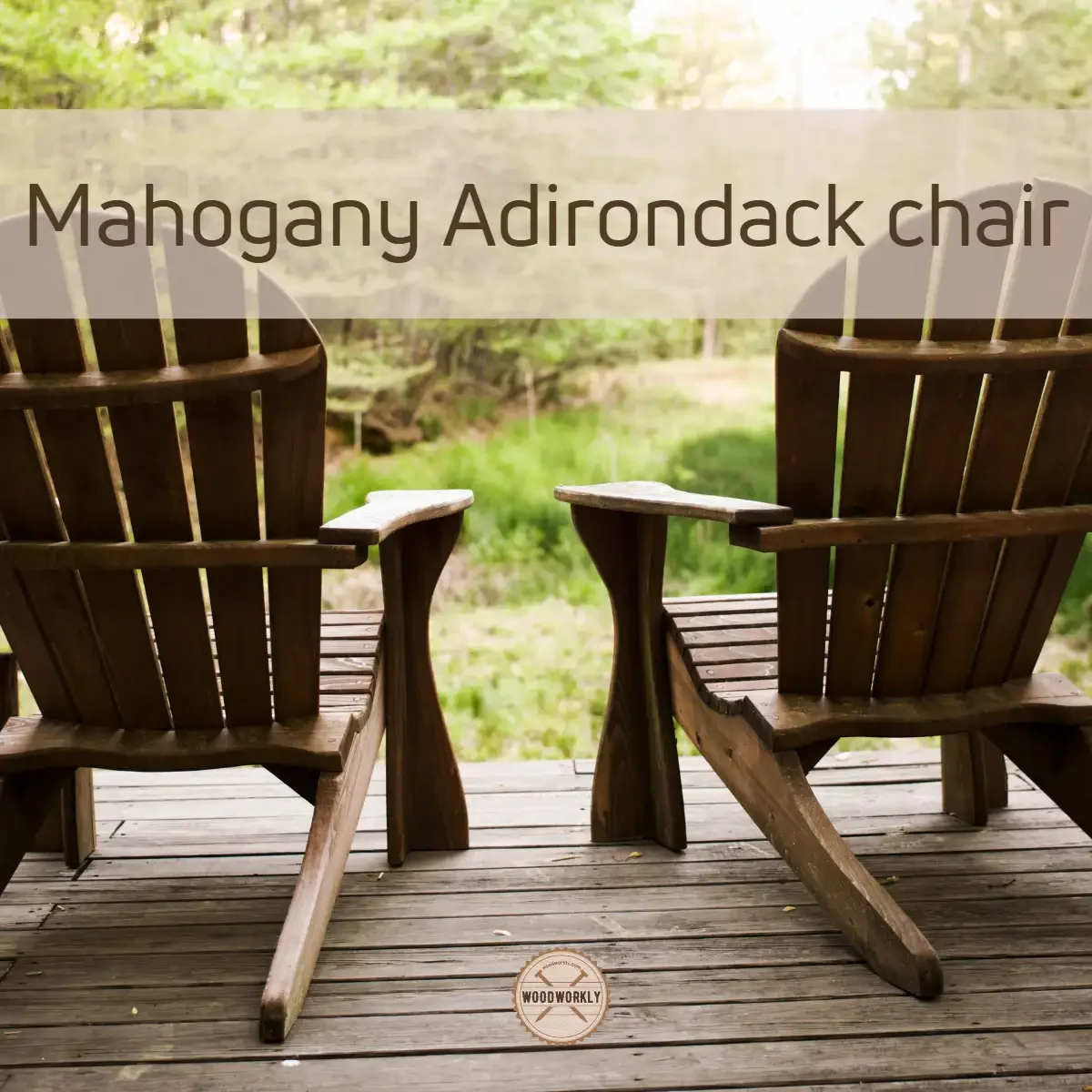
Maintenance
With Mahogany’s inherent resistance to decay and its ability to take sealants and oils well, your chair’s maintenance routine becomes an infrequent, straightforward task.
A periodic application of oil or sealant is sufficient to maintain its rich color and protect it from the elements.
Aesthetics
The passage of time only enhances Mahogany’s visual charm, as its color deepens into a more captivating shade.
As your Adirondack chair ages, it will not only retain its elegance but also acquire a distinguished patina that adds depth and character to your outdoor space.
Sustainability
By opting for sustainably sourced African or Philippine Mahogany, you’re promoting responsible forestry practices and helping to preserve the world’s precious ecosystems.
These eco-friendly alternatives share many qualities with genuine Mahogany, allowing you to enjoy the wood’s virtues without compromising the environment.
As you can see Mahogany is one of the best woods for Adirondack chairs due to the above reasons.
Mahogany’s enchanting beauty, unwavering strength, and natural resilience make it an ideal choice for Adirondack chairs.
A chair forged from this wood will be a statement piece, merging elegance and durability into a luxurious union, inviting you to indulge in the art of relaxation.
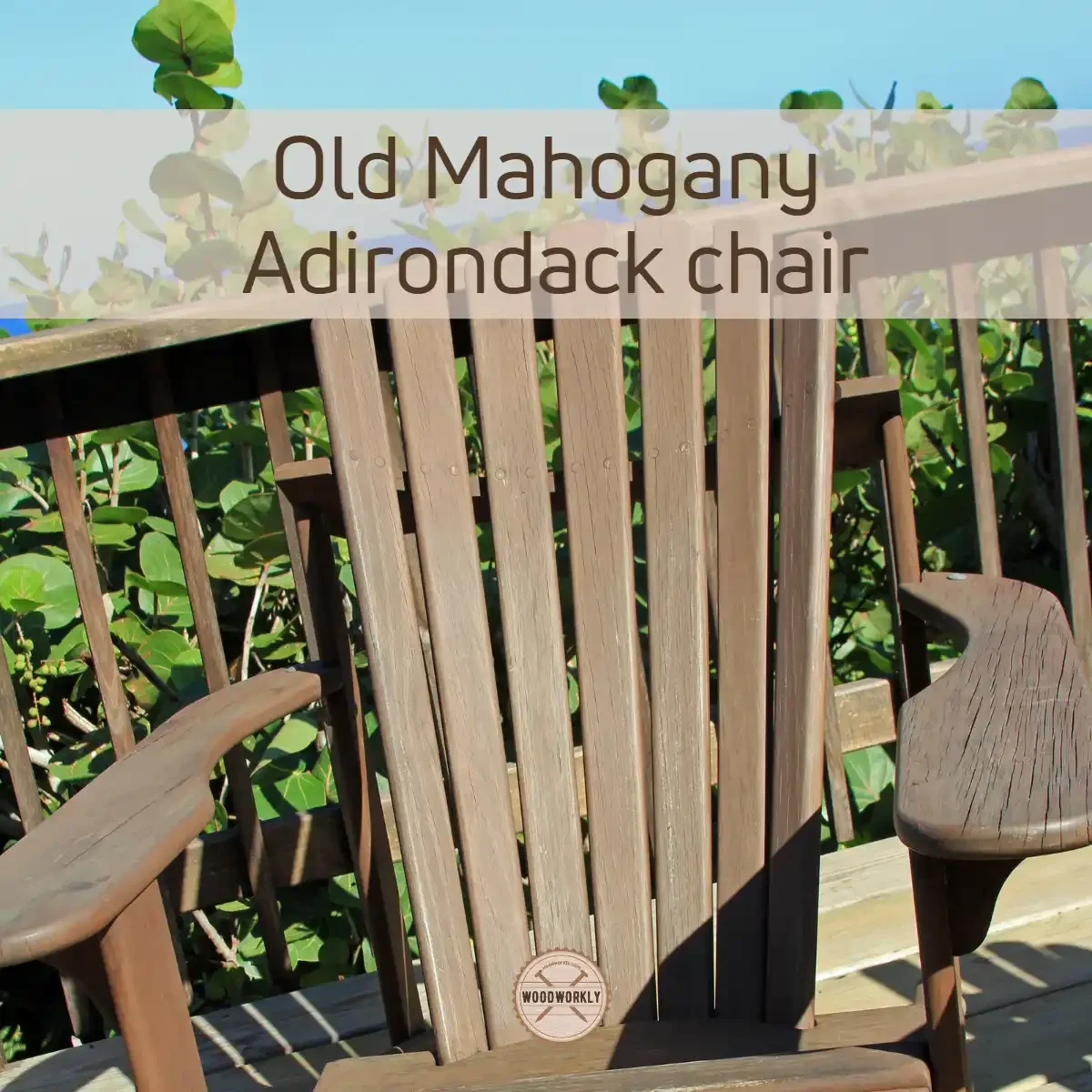
Advantages and Disadvantages Of Using Mahogany For Adirondack Chairs
| Advantages | Disadvantages |
| Highly resistant to decay and insects | Can be expensive compared to other wood options |
| Beautiful reddish-brown color and attractive grain pattern | This may contribute to deforestation due to the high demand |
| Dense and strong, suitable for heavy use | Heavy wood, making it less portable |
| Stable and less prone to warping or twisting | Requires regular maintenance to maintain the appearance |
3. White Oak
White oak is an excellent wood for Adirondack chairs since it can withstand outdoor elements and has high dimensional stability, durability, and strength which is great for the long run.
White oak has high stiffness and is useful for both indoor and outdoor woodworking projects.
With its light to medium brown hue and distinctive, tight grain pattern, White Oak radiates a sense of warmth and tranquility.
This wood’s inviting appearance echoes the serenity of nature, bringing a touch of the forest into your outdoor space.
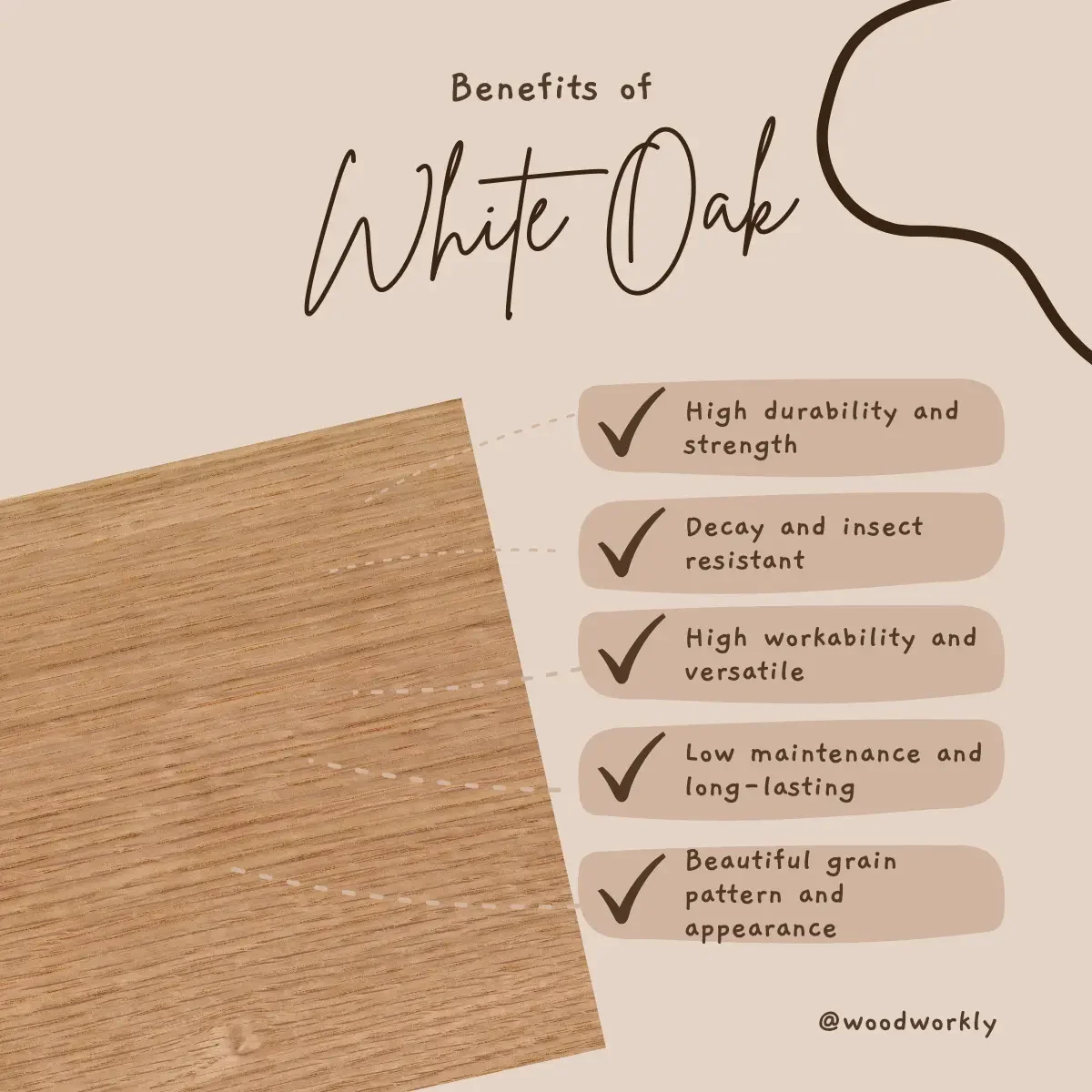
Here’re some qualities of White oak that make it the right wood for the Adirondack chairs,
Durability & Strength
White Oak’s impressive hardness and density contribute to its outstanding durability, providing you with an Adirondack chair that can withstand daily use and resist damage.
As a result, your chair will remain a steadfast fixture in your outdoor haven for years to come.
Decay & Insect Resistance
The tyloses within White Oak’s cellular structure not only impede water absorption but also create a natural barrier against fungal decay and insect infestation.
This innate defense system ensures your Adirondack chair maintains its integrity and beauty, even in harsh outdoor environments.
Workability
White Oak’s workability extends to its compatibility with various woodworking techniques, including gluing, staining, and finishing.
Working with White Oak is even for a beginner in woodworking. You just have to make sure your woodworking tools and well-sharpened since white oak tends to chip away because of its high density.
This versatility allows you to create an Adirondack chair that aligns with your style and preferences, resulting in a truly one-of-a-kind piece.

Maintenance
The low-maintenance nature of White Oak means your Adirondack chair can be easily cared for with periodic cleaning and the occasional application of protective finishes or oils.
This minimal upkeep ensures your chair remains a radiant centerpiece in your outdoor space.
Aesthetics
Over time, White Oak’s color may subtly evolve, imbuing your Adirondack chair with an air of vintage charm.
This wood’s evolving beauty adds depth and character to your outdoor setting, making your chair an enduring testament to the passage of time.
Sustainability
White Oak’s sustainable harvesting practices and abundant availability make it an eco-conscious choice for your Adirondack chair project.
By selecting this wood, you’re contributing to the preservation of our planet’s resources and promoting responsible forestry practices.
White Oak’s unparalleled strength, innate resistance to decay, and captivating aesthetics make it an exceptional choice for Adirondack chairs.
With a chair crafted from this wood, you’ll have a reliable, elegant companion to accompany you on countless outdoor adventures.

Advantages and Disadvantages Of Using White Oak For Adirondack Chairs
| Advantages | Disadvantages |
| Extremely durable and resistant to rot and insects | May be more expensive than other wood options |
| Attractive grain pattern and light color | Heavy wood, making it less portable |
| Excellent weather resistance, suitable for outdoor use | Requires regular maintenance to maintain the appearance |
| Less prone to warping and splitting compared to other woods | Can be difficult to work with due to its density |
4. Yellow Pine
Yellow pine is an affordable option for Adirondack chairs. It has excellent resistance to shrinking and swelling with great dimensional stability.
Those features make it unique and the right wood for the Adirondack chairs.
Plus, it has a beautiful natural appearance with a nice wood grain pattern. This will add a unique look to your outdoor environment.
Yellow Pine’s warm tones, ranging from light yellows to rich ambers, create a cozy ambiance, perfect for an outdoor retreat.
Its distinctive grain patterns further accentuate its allure, adding depth and texture to your Adirondack chair.
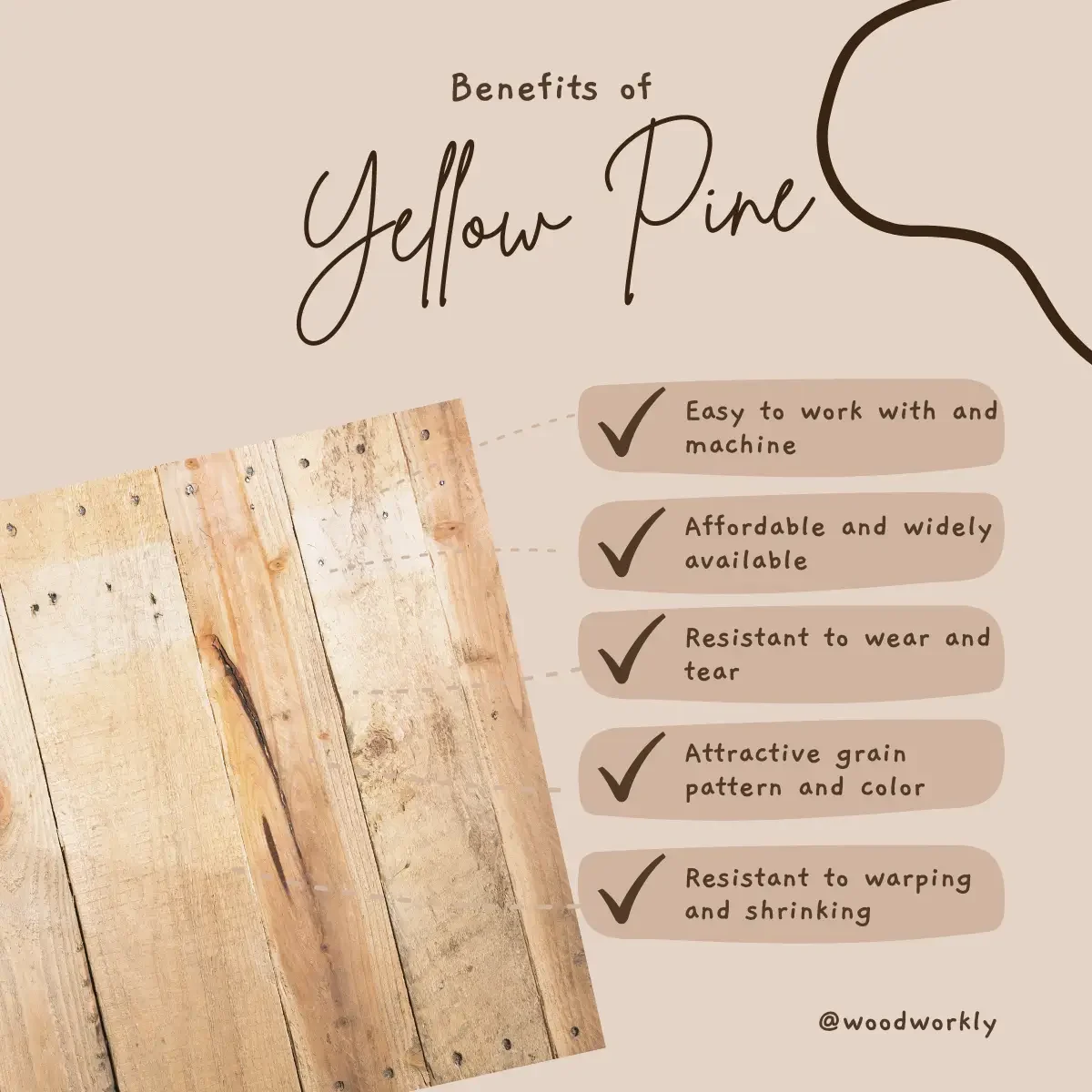
Let’s find out why yellow pine is considered as an ideal choice for Adirondack chairs,
Durability & Strength
Yellow Pine’s hardness and density contribute to its durability, making it a strong contender for outdoor furniture.
As a result, your Adirondack chair will be able to endure frequent use and weather fluctuations, remaining a steadfast fixture in your outdoor space.
Decay & Insect Resistance
Pressure-treated Yellow Pine is infused with chemicals that not only increase its resistance to decay but also deter insects from feasting on it.
This added protection ensures your Adirondack chair remains in pristine condition, even when exposed to the harsh elements of the outdoors.
Workability
Working with yellow pine is super easy since it is softwood with great workability.
Yellow Pine’s workability extends to its compatibility with various woodworking techniques, such as gluing, staining, and painting.
This versatility allows you to create an Adirondack chair that aligns with your personal style and preferences, resulting in a truly one-of-a-kind piece.
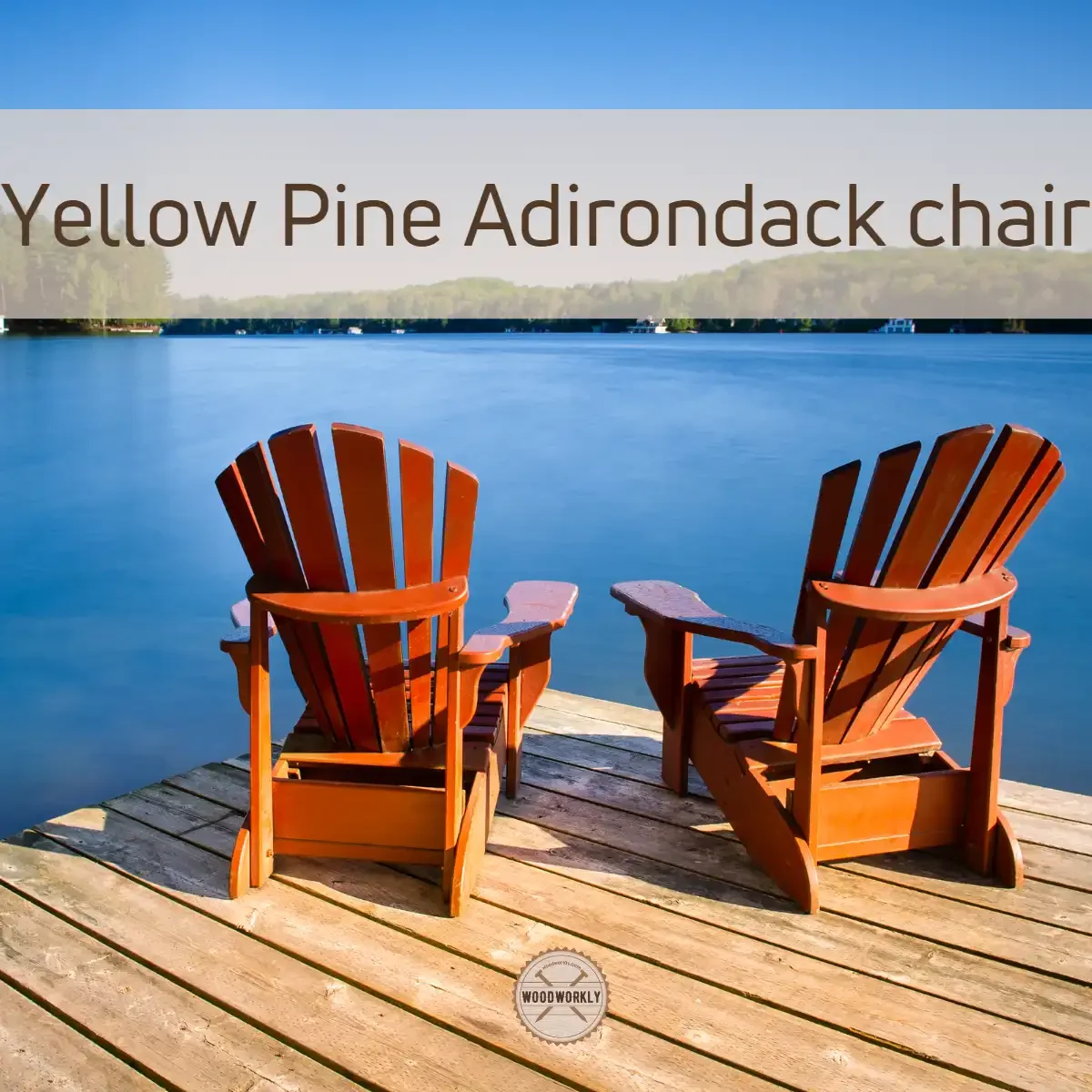
Maintenance
Yellow Pine’s low-maintenance nature means your Adirondack chair can be easily cared for with periodic cleaning and the occasional application of protective finishes or paint.
This minimal upkeep ensures your chair remains a radiant centerpiece in your outdoor space.
Aesthetics
Over time, Yellow Pine’s color may subtly deepen, imbuing your Adirondack chair with an air of warmth and sophistication.
This wood’s evolving beauty adds depth and character to your outdoor setting, making your chair an enduring testament to the passage of time.
Budget
Yellow Pine’s affordability extends to its cost-effective maintenance and care, ensuring that your Adirondack chair project remains budget-friendly in the long run.
By choosing this wood, you’re making a wise investment in both your outdoor space and your wallet.
Yellow Pine’s durability, workability, and undeniable charm make it an excellent choice for Adirondack chairs.
Crafted from this wood, your chair will serve as a comfortable and inviting sanctuary, providing the perfect backdrop for cherished outdoor moments.

Advantages and Disadvantages Of Using Yellow Pine For Adirondack Chairs
| Advantages | Disadvantages |
| Affordable and widely available | Requires regular maintenance to prevent rot and decay |
| Easy to work with and accepts stains and finishes well | Less resistant to insects compared to other wood types |
| Strong and durable for outdoor furniture | Can be prone to warping and splitting in harsh weather |
| Attractive grain pattern and natural color | Heavier than some other wood options |
5. Teak
Teak is an excellent wood for Adirondack chairs because it has excellent durability, and strength and you can use Teak Adirondack chairs for so long with no issues.
Teak, a tropical hardwood revered for its luxurious appearance and exceptional qualities, boasts a rich golden-brown hue that is both captivating and sophisticated.
With its straight grain patterns and a touch of silvery shimmer, Teak stands as a paragon of elegance, ready to elevate any Adirondack chair to a whole new level of refinement.
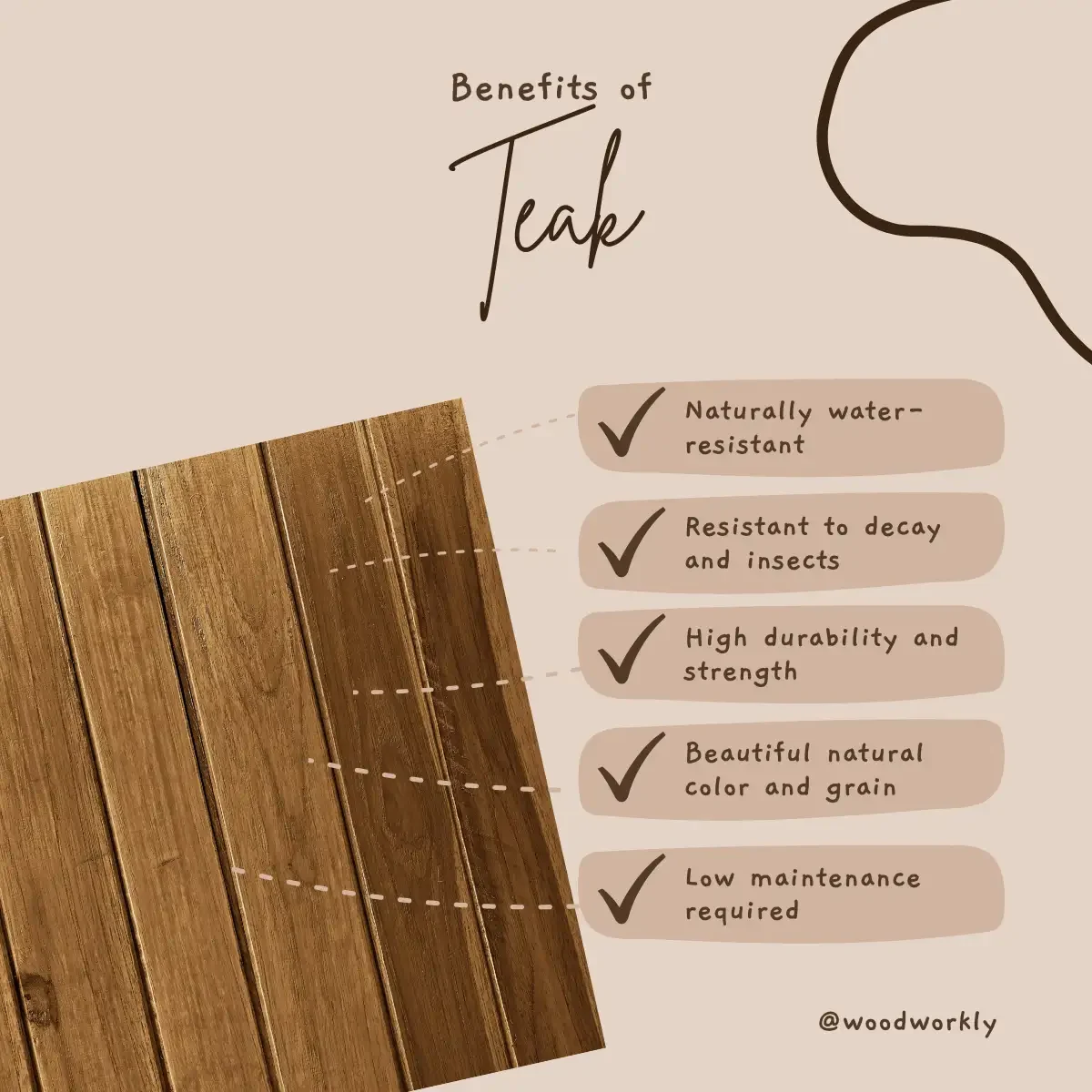
Here’re some characteristic qualities that make Teak wood great for Adirondack chairs,
Durability & Strength
Teak’s strength is rooted in its tight grain and high oil content, which provide resistance to warping, splitting, and cracking.
Your Adirondack chair will be a lasting testament to Teak’s endurance, gracefully withstanding the test of time.
Decay & Insect Resistance
The natural oils and silica found in Teak not only protect against decay but also make it unpalatable to insects.
This inherent defense mechanism ensures your Adirondack chair remains free of damage, even in the face of unrelenting outdoor elements.
Workability
Teak’s cooperative nature extends to its compatibility with various woodworking tools and techniques, such as sawing, gluing, and carving.
Since teak wood is difficult to cut and nail, your woodworking tools should be well-sharpened to avoid wood from chipping away.
This versatility allows you to create an Adirondack chair that reflects your unique vision and artistry.
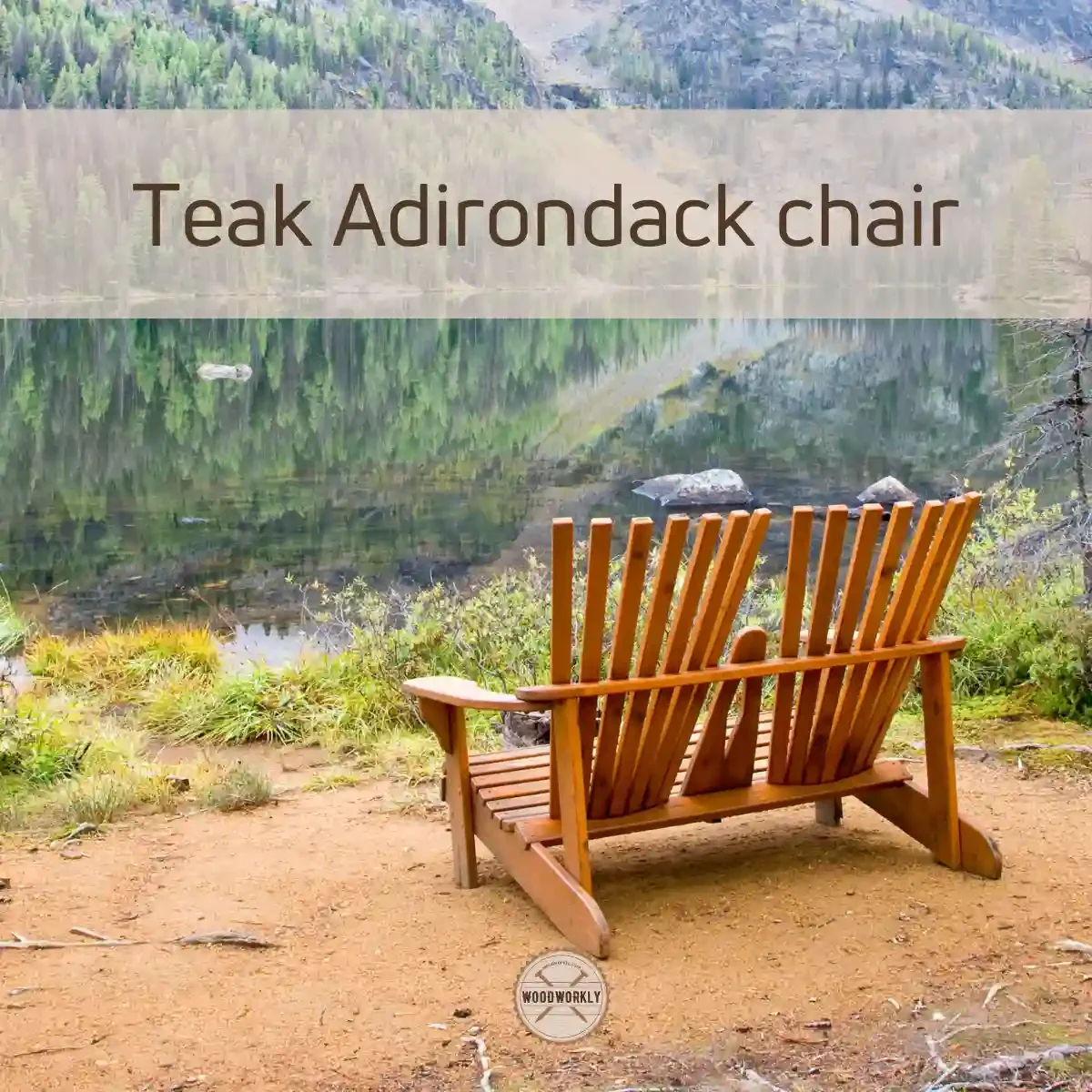
Maintenance
Teak’s ability to weather gracefully, turning a beautiful silvery-gray over time, means your Adirondack chair will require minimal upkeep.
With just a bit of care, your chair will maintain its stunning appearance, effortlessly enhancing your outdoor living space.
Aesthetics
Teak’s rich hues and luxurious appearance are hallmarks of quality, making it a sought-after material for high-end outdoor furniture.
Your Adirondack chair, crafted from this exquisite wood, will be an elegant addition to your garden or patio, evoking a sense of sophistication and refinement.
Sustainability
When responsibly harvested, Teak contributes to a sustainable forestry ecosystem that supports local communities and biodiversity.
By selecting FSC-certified Teak, you’re making a conscious choice to support the environment while creating a luxurious and durable Adirondack chair.
Teak’s combination of durability, low maintenance, and unparalleled beauty make it an excellent choice for Adirondack chairs.
When fashioned from this remarkable wood, your chair will stand as a testament to both luxury and resilience, providing a welcoming retreat for years to come.

Advantages and Disadvantages Of Using Teak For Adirondack Chairs
| Advantages | Disadvantages |
| Highly resistant to rot, decay, and insects | Expensive compared to other wood types |
| Requires little maintenance and weathers beautifully | Can be difficult to work with due to high density |
| Extremely durable and long-lasting | Limited availability and potential for unsustainable harvesting |
| Rich, golden-brown color and tight grain pattern | May require occasional oiling to maintain color |
6. Ipe Or Brazilian Walnut
Ipe which is also known as Brazilian walnut is a wood with high strength and durability which is an ideal choice for Adirondack chairs.
Since Ipe wood has good resistance against outdoor elements like moisture, it is mostly used for outdoor woodworking projects. I’ve seen beautiful and strong fences made with Ipe wood.
With its striking dark brown to reddish hues and interlocking grain patterns, Ipe emanates a sense of luxury and strength, making it an excellent choice for Adirondack chairs and other outdoor furniture.

Here’re what make Ipe wood ideal for Adirondack chairs,
Durability & Strength
Ipe’s impressive strength is attributed to its high density, which is near twice that of some other hardwoods.
This extraordinary resilience ensures that your Ipe Adirondack chair will remain steadfast and reliable for years, even when faced with harsh weather conditions and daily wear.
Decay & Insect Resistance
The naturally occurring chemicals within Ipe not only provide resistance to decay but also create an inhospitable environment for insects, such as termites.
These innate protective properties help maintain the structural integrity and appearance of your Ipe Adirondack chair, requiring minimal intervention on your part.
Workability
While Ipe’s density may pose a woodworking challenge, using sharp tools and pre-drilling screw holes can mitigate these difficulties.
By exercising patience and skill, you can create a stunning Adirondack chair that showcases Ipe’s captivating beauty and demonstrates your mastery of woodworking.

Maintenance
Ipe’s ability to resist weathering means that your Adirondack chair can gracefully age without compromising its structural integrity.
An occasional application of Ipe oil will help retain its vibrant color, or you may choose to let it develop a silvery-gray patina, both options lending a distinct charm to your outdoor space.
Aesthetics
Ipe’s rich color variations and intricate grain patterns exude an air of luxury and sophistication.
This striking visual appeal transforms your Adirondack chair into an eye-catching statement piece, elevating your outdoor living area and setting the stage for leisurely afternoons and memorable gatherings.
Sustainability
By opting for FSC-certified Ipe, you’re making an environmentally conscious decision that supports responsible forestry practices.
In turn, you contribute to the preservation of tropical rainforests and the delicate ecosystems they support.
Ipe’s outstanding durability, decay resistance, and captivating aesthetics make it a prime choice for Adirondack chairs.
An Ipe Adirondack chair will not only be a beautiful addition to your outdoor space but also a lasting investment that withstands the test of time.

Advantages and Disadvantages Of Using Ipe For Adirondack Chairs
| Advantages | Disadvantages |
| Incredibly strong and dense, offering excellent durability | Very expensive compared to other wood types |
| Highly resistant to rot, decay, and insect damage | Difficult to work with due to its hardness and density |
| Low maintenance and can last for decades | Heavy, making it less suitable for easy repositioning |
| Attractive dark-brown color with fine grain texture | May require occasional oiling to maintain color |
7. Red Oak
Red oak is also an excellent choice for Adirondack chairs as white oak. Red oak is durable, attractive, and able to withstand extreme weather which makes it great for an outdoor project like this.
Red oak is known for its distinctive reddish-brown hue and unique grain pattern.
With a warm, inviting appearance, Red Oak adds a touch of natural elegance to any furniture piece, including Adirondack chairs.
The wood’s coarse texture and unmistakable straight grain make it a visually appealing choice for woodworking projects.
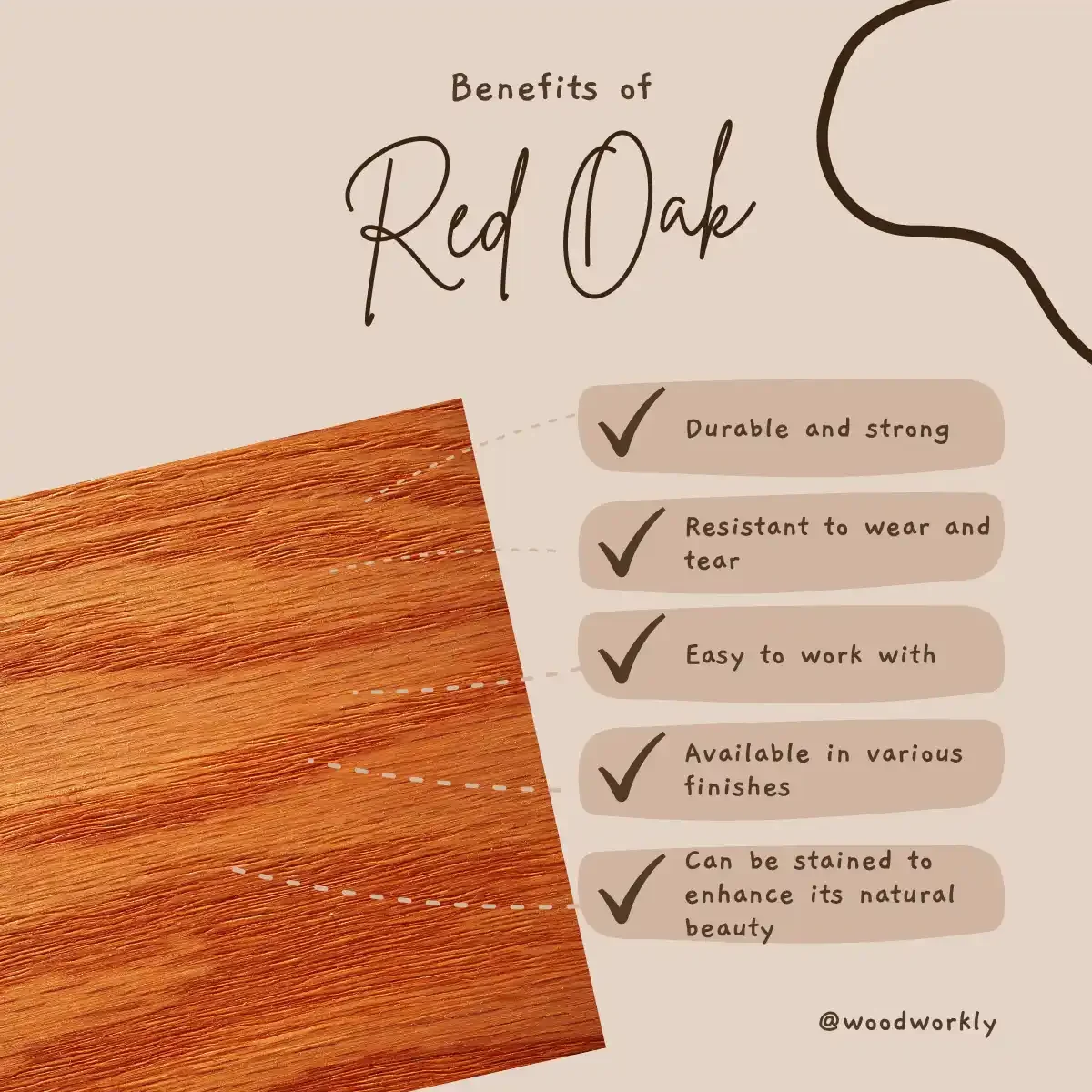
Here’re some qualities of Red Oak which are useful when making Adirondack chairs,
Durability & Strength
Red Oak’s impressive strength-to-weight ratio lends itself to the creation of long-lasting furniture pieces.
Although not as resistant to rot and insects as some other hardwoods, proper care and treatment can enhance Red Oak’s outdoor performance, ensuring your Adirondack chairs stay strong for years to come.
Workability
The wood’s open grain structure and even texture make it a pleasure to work with. Its ability to hold screws and nails without splitting is an added advantage for crafting Adirondack chairs.
However, it’s worth noting that Red Oak’s porous nature can make staining tricky, so a careful approach is essential to achieve a flawless finish.
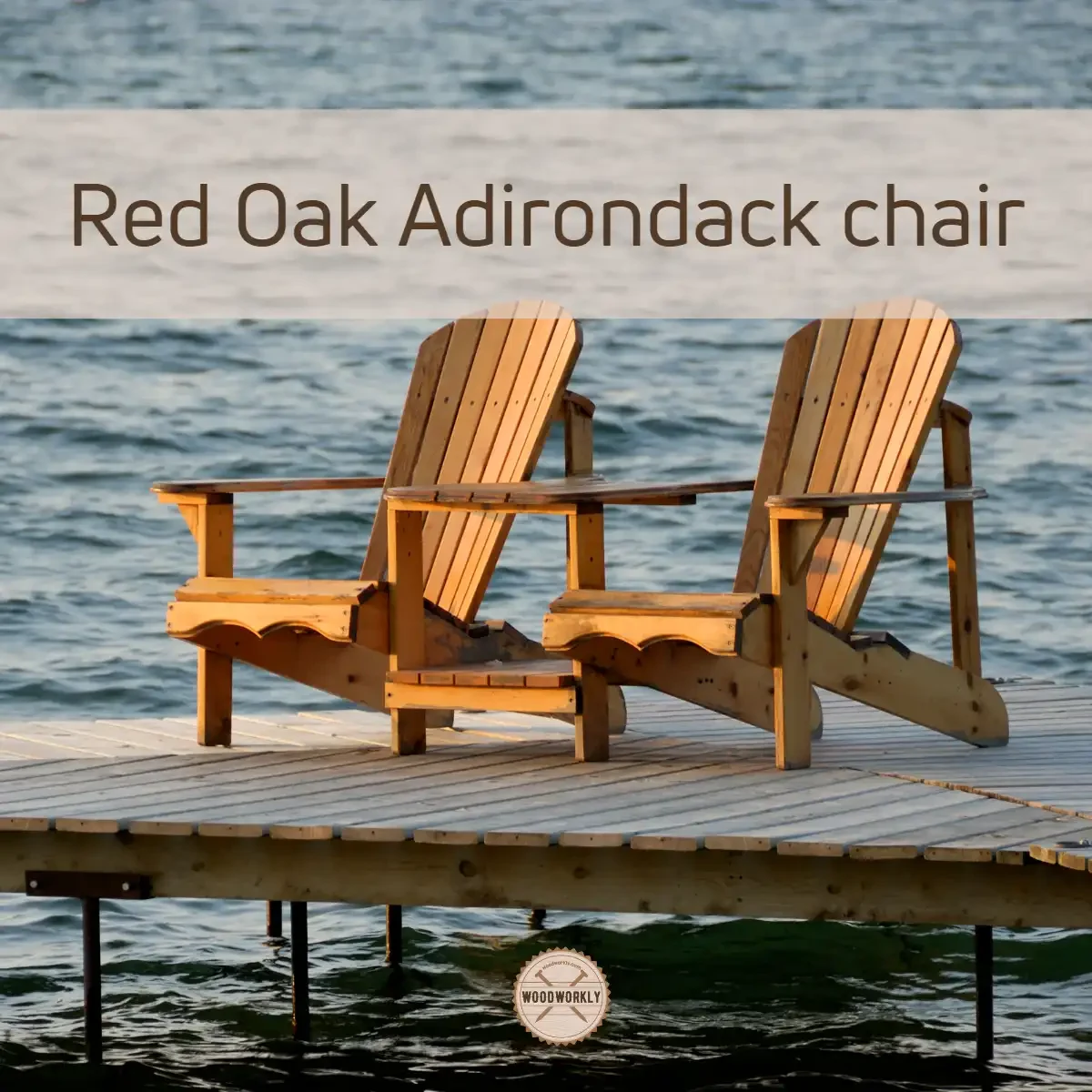
Aesthetics
The rich color variation and distinct grain pattern of Red Oak add depth and visual interest to Adirondack chairs.
Its eye-catching appearance has the ability to elevate any outdoor space, making it a popular choice among homeowners and designers alike who are looking for that perfect combination of style and substance.
Affordability
Red oak is a budget-friendly option for Adirondack chairs.
While Red Oak is not the least expensive wood on the market, it offers a good balance between cost and quality.
Its widespread availability contributes to its relatively lower price, making it an attractive option for those looking to enjoy the benefits of hardwood without straining their budget.
Sustainability
The abundance of Red Oak in North America means that responsibly sourced lumber is readily available.
By opting for Red Oak from sustainably managed forests, you can have peace of mind knowing that your Adirondack chair contributes to responsible forestry practices and supports the long-term health of our environment.
Red Oak requires extra care to maintain its appearance and longevity outdoors.
Applying a quality exterior finish and shielding the chair from extreme weather conditions will help preserve its natural beauty and extend its lifespan.
Therefore, make sure to finish red oak with a quality sealer like Danish oil, tung oil, lacquer, or varnish to keep your Adirondack chair for a long time in fresh appearance.
While Red Oak may not be the most weather-resistant choice, its charm, workability, and affordability make it an appealing option for Adirondack chair enthusiasts.
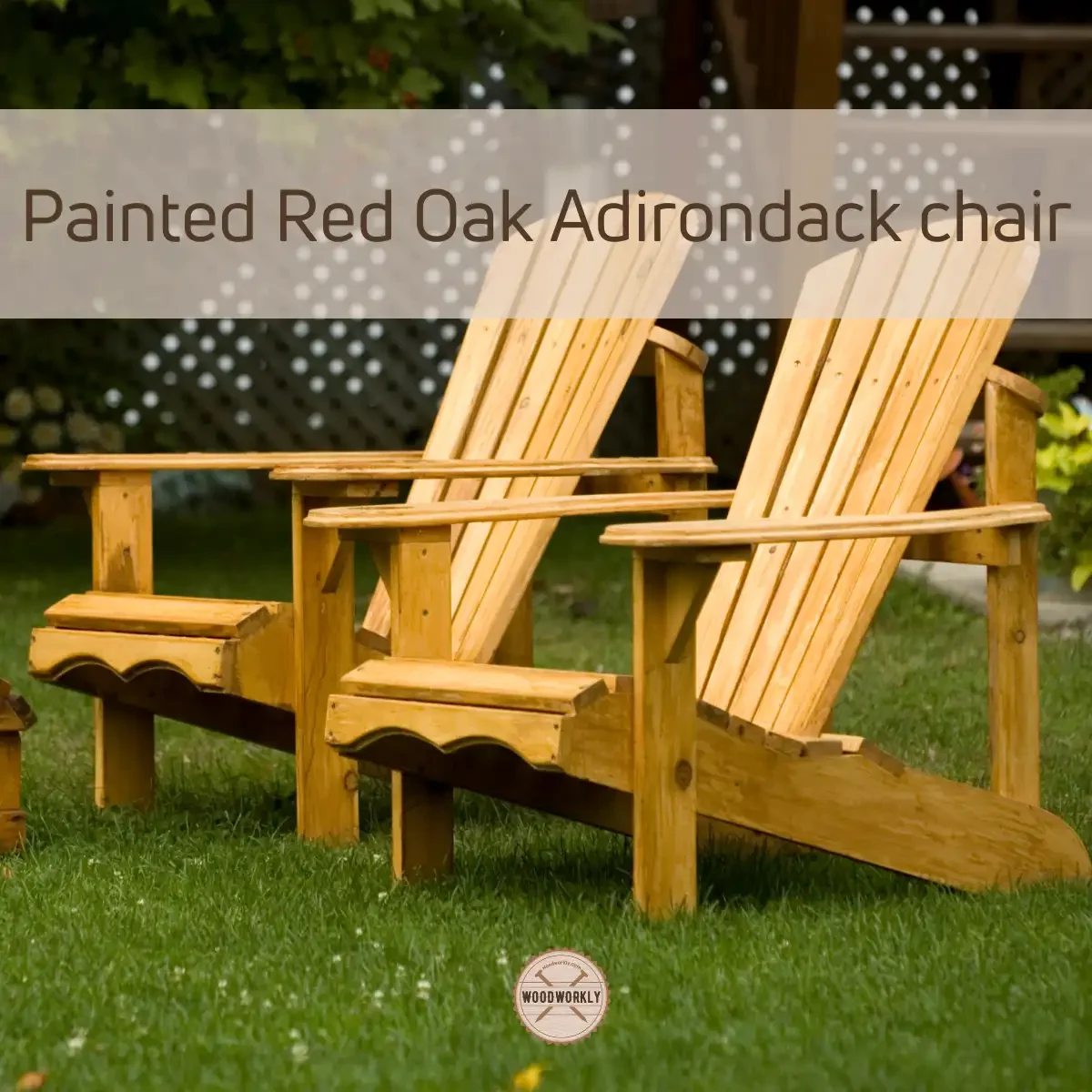
Advantages and Disadvantages Of Using Red Oak For Adirondack Chairs
| Advantages | Disadvantages |
| Aesthetically pleasing with attractive grain patterns | Less resistant to rot and decay compared to White Oak |
| Readily available and affordable | May require regular maintenance to preserve its finish |
| Easy to work with, making it suitable for DIY projects | Not the best choice for outdoor furniture in damp areas |
| Offers good strength and stability | Requires sealing to improve weather resistance |
8. Cypress
Cypress is an ideal choice for making Adirondack chairs because it has properties of both softwoods and hardwoods. It has a 510 lbf of Janka hardness rating and has good workability and dimensional stability.
Cypress presents itself with a pale-yellow hue and a straight, medium-grained texture.
Its look, occasionally showcasing small knots, gives it a rustic charm that enhances the appearance of outdoor furniture.

Cypress is valued as a top choice for Adirondack chairs for several reasons:
Durability & Strength
Cypress wood’s strength allows it to bear the weight of users comfortably, while its inherent durability ensures that your Adirondack chairs will last for years.
Moreover, the cypress’s ability to withstand harsh weather conditions, such as rain and humidity, makes it a reliable choice for outdoor furniture.
Workability
The ease of working with cypress allows even novice woodworkers to create stunning Adirondack chairs.
Its adaptability to various woodworking tools and techniques enhances its appeal, ensuring that intricate details and designs can be executed effortlessly.
Aesthetics
Cypress’s unique grain patterns and subtle knots make each piece of furniture distinctive.
The wood’s pale yellow hue ages gracefully, developing a rich patina over time, which adds character to your outdoor living space and enhances the overall ambiance.
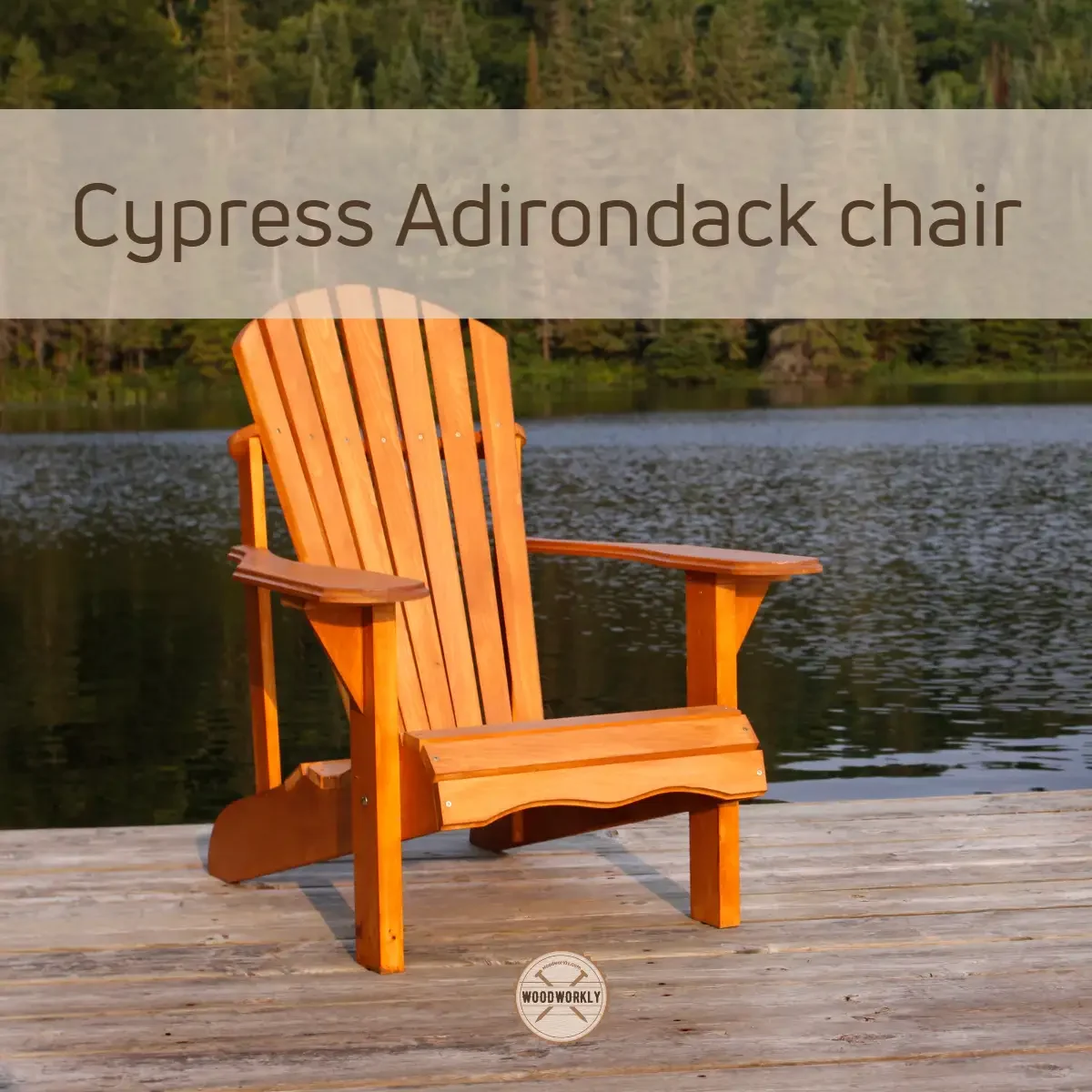
Maintenance
A simple cleaning regimen involving mild soap and water will keep your cypress Adirondack chairs looking fresh.
Additionally, applying a UV-resistant sealer every few years will help protect the wood from discoloration and maintain its original beauty.
Apply a thin coat of finish over the cypress to get an even looking finish with a nicer look
Sustainability
Choosing cypress for your Adirondack chairs supports responsible forestry practices.
As cypress trees grow relatively fast, their cultivation is less taxing on the environment than that of slow-growing hardwoods.
By selecting cypress, you’re not only investing in a quality material but also contributing to a more sustainable future.
Cypress offers a compelling blend of durability, workability, aesthetics, low maintenance, and sustainability.
Its innate resistance to decay and insects, combined with its appealing appearance, makes it an ideal wood for crafting Adirondack chairs that are both beautiful and long-lasting.
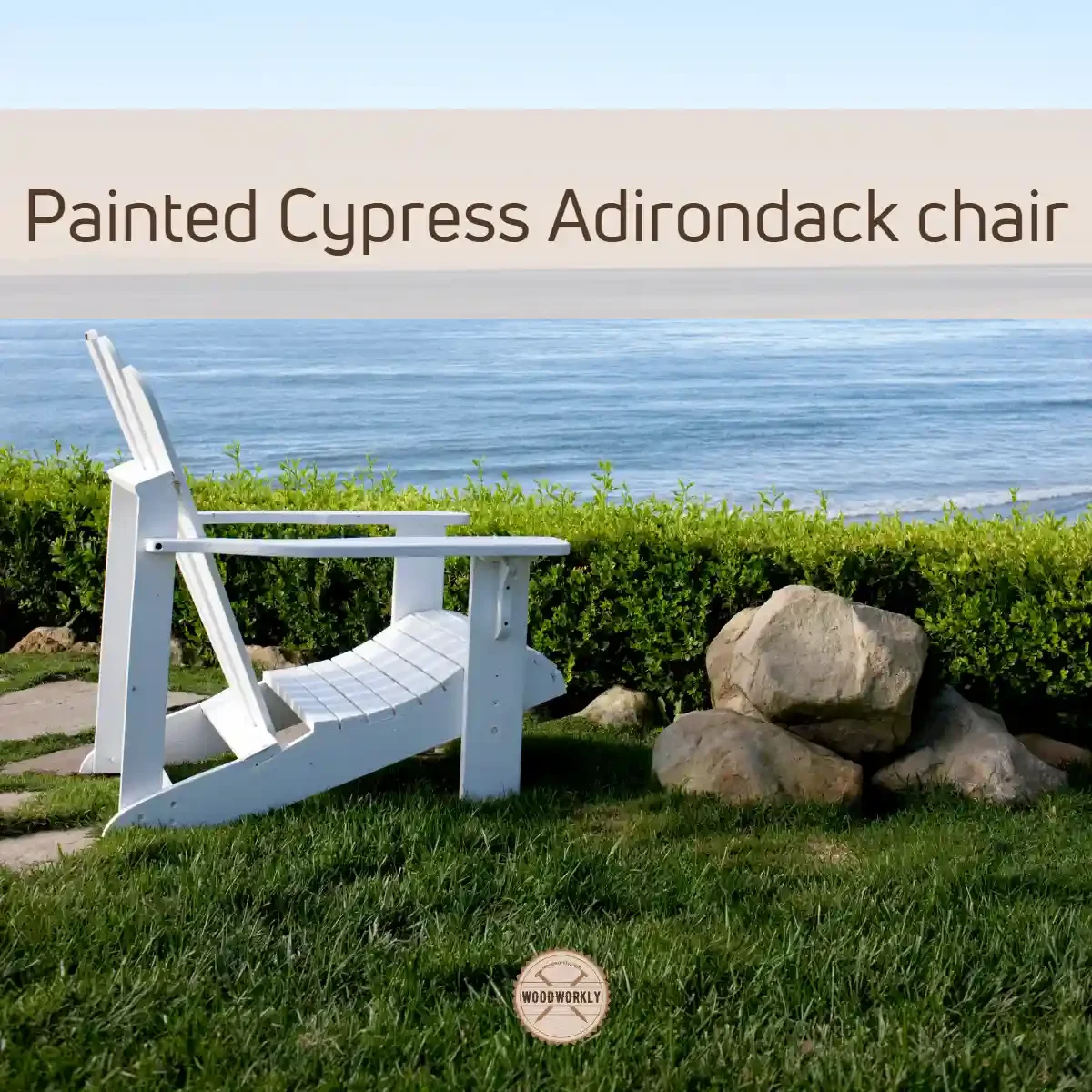
Advantages and Disadvantages Of Using Cypress For Adirondack Chairs
| Advantages | Disadvantages |
| Naturally resistant to rot, decay, and insects | Maybe less available in certain regions |
| Aesthetically appealing with a fine grain pattern | Less durable than some other hardwoods, like Teak or Ipe |
| Stable and less prone to warping or shrinking | Can be more expensive than other softwoods |
| Does not require frequent maintenance or sealing | Color may gray over time if not treated with a UV blocker |
9. Douglas Fir
Douglas fir is a softwood which is easy to work with and able to protect with almost any wood finish. Therefore, it is an excellent choice for making Adirondack chairs.
Douglas Fir has a unique reddish-brown hue with striking grain patterns.
Its appearance varies from light, golden hues to deep reddish-browns, accentuated by tight, swirling grain patterns that lend visual interest and charm to any piece of furniture.
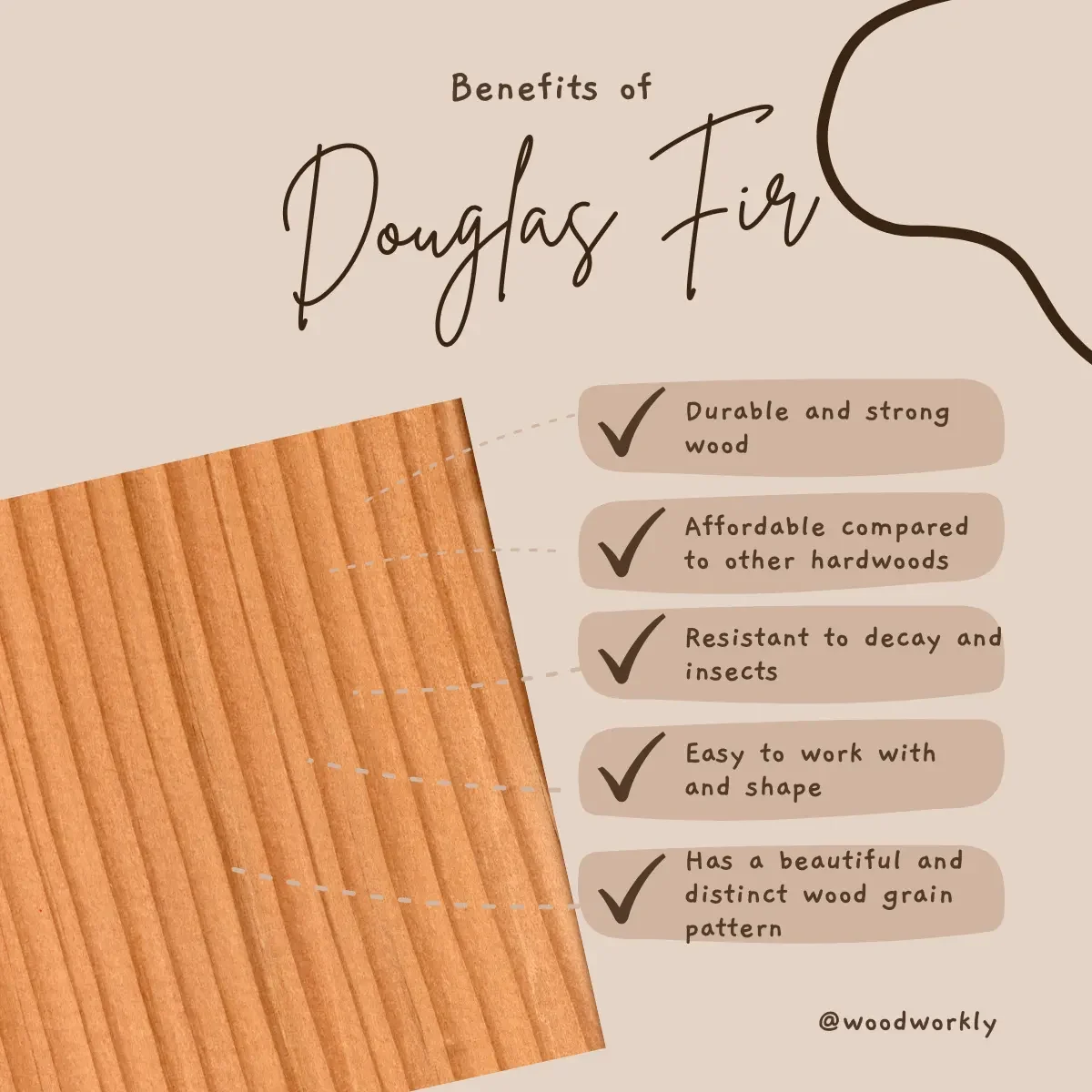
Here’re some qualities that make Douglas Fir Great for Adirondack chairs,
Strength & Weight
Douglas Fir’s exceptional strength-to-weight ratio sets it apart from other softwoods.
This attribute makes it ideal for constructing sturdy Adirondack chairs that are not only robust but also lightweight enough for easy handling and transportation.
Weather Resistance
While Douglas Fir’s natural resistance to decay is moderate, applying regular maintenance in the form of sealants and stains significantly enhances its durability.
This additional protection helps maintain the wood’s integrity and extends the lifespan of Adirondack chairs exposed to the elements.
Workability
The smooth texture of Douglas Fir, combined with its lack of resin, allows for precise cuts and shaping with woodworking tools.
This feature is particularly beneficial for novice woodworkers looking to hone their skills and create Adirondack chairs with intricate detailing.

Affordability
Compared to some of its hardwood counterparts, Douglas Fir offers an economical alternative without sacrificing quality.
By opting for this cost-effective wood, you can create impressive Adirondack chairs while keeping your expenses in check.
Sustainability
Douglas Fir’s popularity as a construction material has led to responsible forestry practices and efficient reforestation efforts.
By choosing this sustainable wood, you are contributing to the preservation of our planet’s resources and promoting environmentally conscious woodworking.
By selecting Douglas Fir for your Adirondack chair project, you’ll be crafting stunning, resilient furniture while making a cost-effective choice.

Advantages and Disadvantages Of Using Douglas Fir For Adirondack Chairs
| Advantages | Disadvantages |
| Relatively affordable and widely available | Requires regular maintenance and sealing |
| Strong and durable when treated properly | Susceptible to rot, decay, and insects if not treated |
| Lightweight and easy to work with for DIY projects | May warp or crack if exposed to moisture and temperature |
| Aesthetically appealing with straight grain and reddish hue | Not as long-lasting as other hardwoods, like Teak or Ipe |
10. Eucalyptus
Eucalyptus wood is a popular wood type when it comes to outdoor woodworking projects due to its water resistance, weather resistance, and rot resistance. Therefore, it is an ideal choice for Adirondack chairs.
Eucalyptus is a rapidly-growing hardwood native to Australia and exhibits a stunning array of colors and grain patterns, ranging from pale cream to rich red-brown hues.
Its natural beauty and distinct appearance make it an attractive choice for outdoor furniture, including Adirondack chairs.
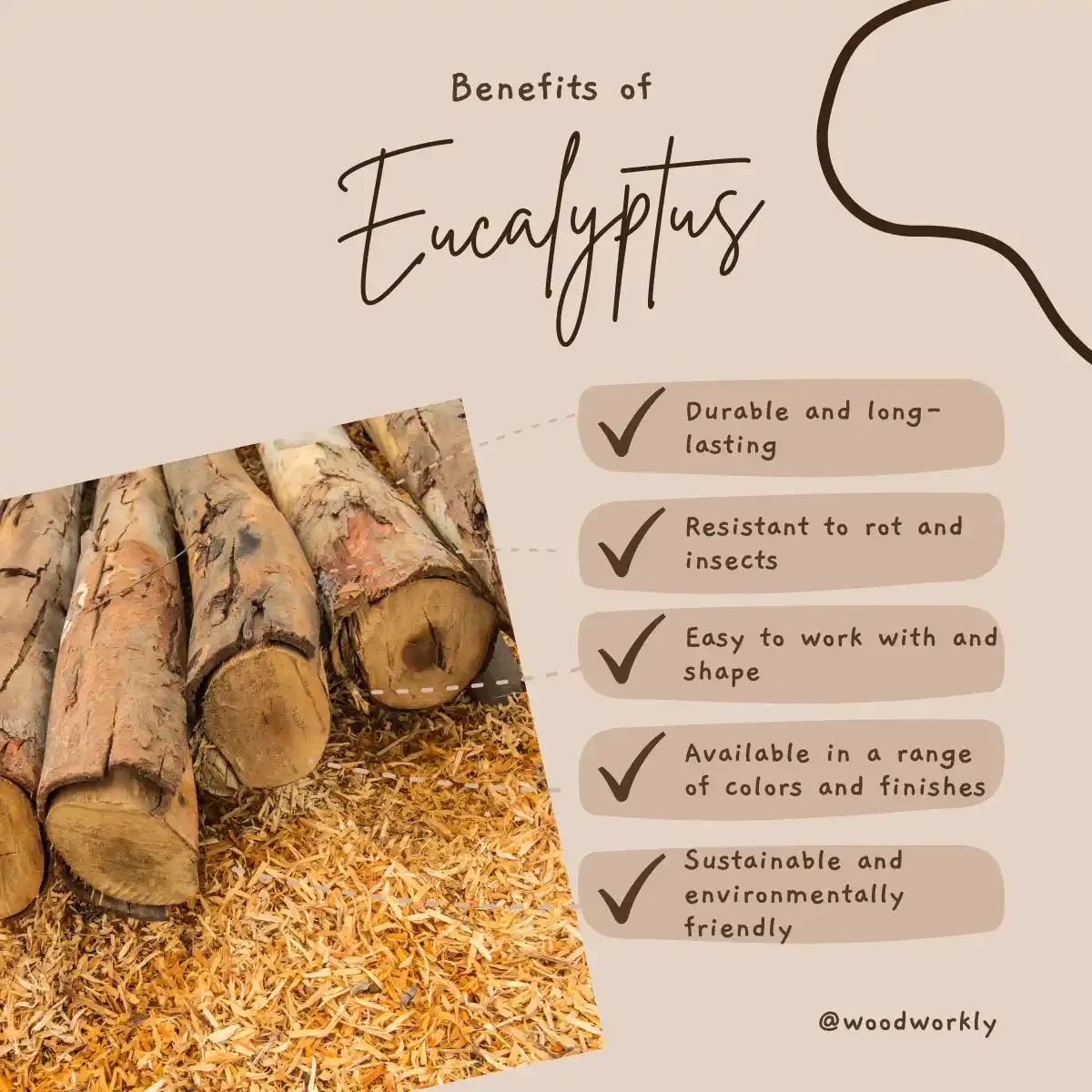
Here’re some characteristic qualities of eucalyptus wood that make it great for Adirondack chairs,
Durability & Rot Resistance
Eucalyptus wood is renowned for its ability to endure even in damp or humid conditions.
Because of having excellent durability, you can use eucalyptus Adirondack chairs for years without any issues. It has a high tolerance for extreme weather conditions.
Its natural resilience against rot and decay ensures that your Adirondack chairs will remain sturdy and reliable for years to come, reducing the need for frequent replacements or repairs.
Density & Strength
The high density of Eucalyptus wood means it can withstand significant stress without bending or breaking, allowing it to support the weight of users comfortably.
Because of having high density and strength, eucalyptus Adirondack chairs have good dimensional stability which is important in long run.
This strength translates to a longer-lasting chair, capable of withstanding daily wear and tear, as well as more extreme weather events.
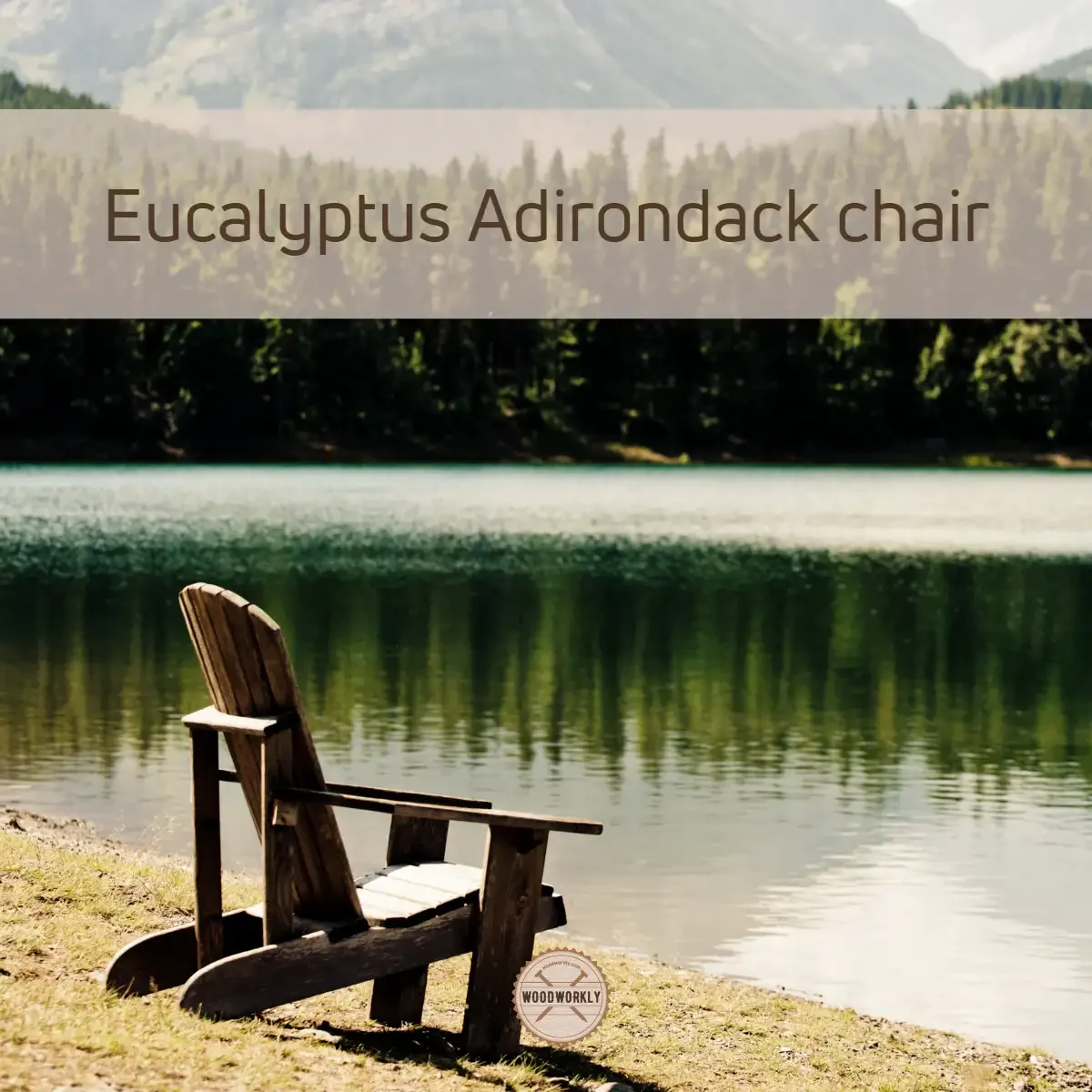
Weather Resistance
The inherent weather-resistant properties of Eucalyptus wood mean that your Adirondack chairs can handle exposure to rain, sun, and even snow.
Being water-resistant is the key feature that eucalyptus wood stands out compared to other woods.
As a result, these chairs require less maintenance and upkeep, allowing you to spend more time enjoying your outdoor space instead of tending to your furniture.
Eco-Friendliness
Eucalyptus trees grow quickly and require less land, water, and other resources to produce compared to other hardwoods.
This rapid growth and efficient resource usage contribute to a smaller carbon footprint, making Eucalyptus a greener choice for your Adirondack chairs and outdoor projects.
Workability
Eucalyptus wood’s favorable workability allows skilled craftsmen to shape and mold it into intricate designs, adding an extra touch of elegance and uniqueness to your Adirondack chairs.
Make sure to sharpen your woodworking tools well before working with eucalyptus to avoid wood from chipping away during the process.
However, it’s crucial to note that Eucalyptus’s density can make it challenging to work with, so using sharp tools and taking your time is essential to achieve the desired outcome.
Eucalyptus’s unique combination of durability, strength, weather resistance, eco-friendliness, and workability make it a top contender for crafting beautiful and long-lasting Adirondack chairs.
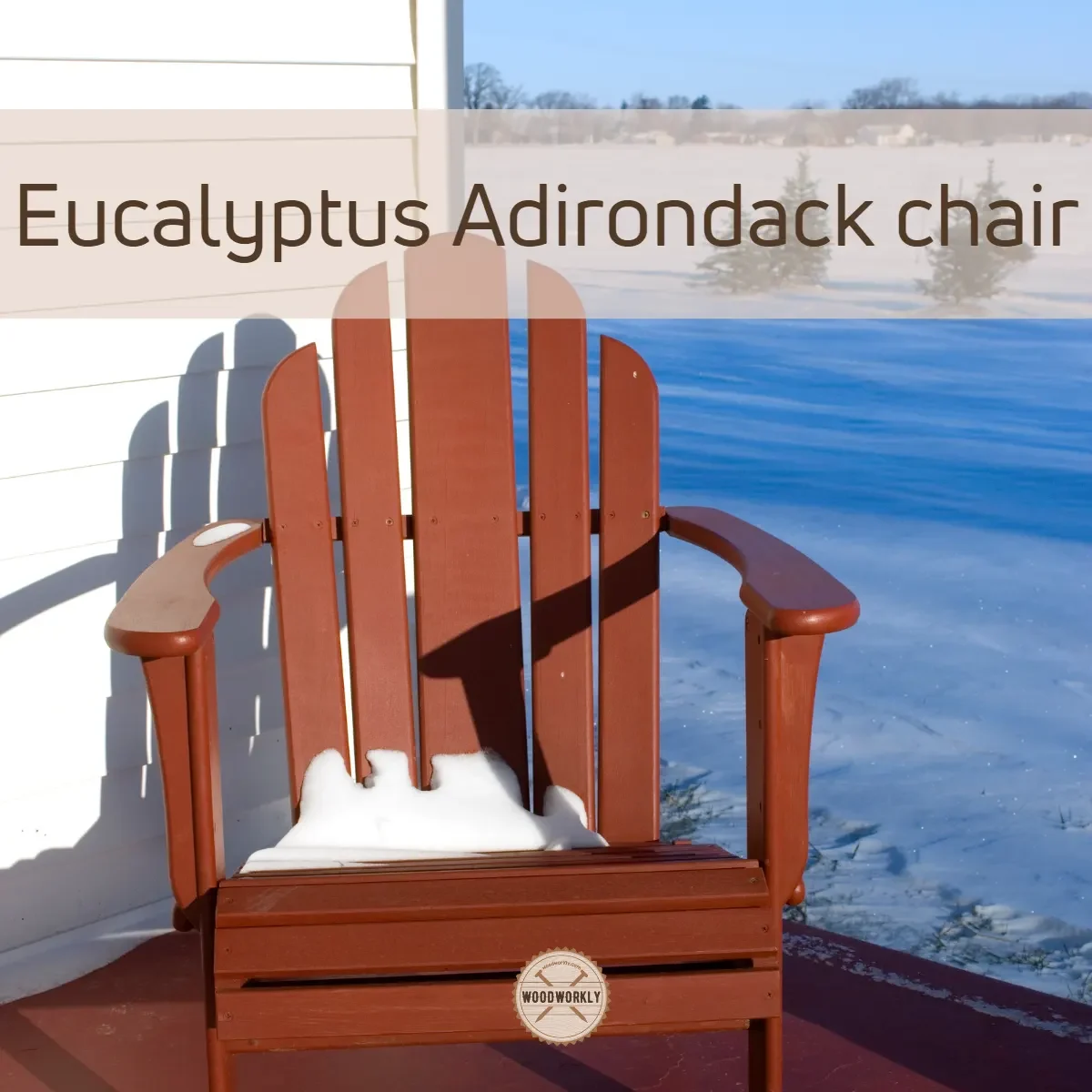
Advantages and Disadvantages Of Using Eucalyptus For Adirondack Chairs
| Advantages | Disadvantages |
| Sustainable and eco-friendly choice with fast-growing trees | Prone to warping and splitting if not dried and treated well |
| Durable and resistant to rot and insects | Less availability compared to other woods |
| Natural oils provide a built-in weather-resistant finish | Requires regular maintenance to retain its appearance |
| Typically more affordable than teak or ipe | Not as long-lasting as some other hardwoods |
11. Acacia
Acacia wood is a hardwood with an incredible hardness of 2300 lbf which is harder, stronger, and denser than many other kinds of wood. Because of being this hard, it has become an ideal choice for an outdoor project like Adirondack chairs.
You can use acacia wood pretty much for any woodworking project. it is beautiful and able to protect from outdoor elements by finishing with a quality sealer.
It is a versatile, exotic hardwood known for its distinctive grain patterns and rich golden-brown hues.
Typically found in tropical and subtropical regions, Acacia is highly sought after for its robustness and appealing aesthetic.

Here’re some characteristic features that make acacia wood great for making Adirondack chairs,
Durability & Strength
Acacia’s impressive hardness and strength make it less likely to warp, crack, or split when exposed to harsh elements or heavy use.
This robustness provides a sense of security, knowing that your Adirondack chairs will maintain their structure and functionality even after years of use.
Rot & Insect Resistance
The natural oils and compounds found within Acacia wood act as a deterrent for wood-boring insects, reducing the risk of infestations that could compromise the chair’s structure.
Additionally, these oils grant Acacia its inherent resistance to rot and decay, ensuring your outdoor furniture remains in excellent condition despite exposure to moisture and humidity.
Weather Resistance
Acacia’s ability to adapt to various environmental conditions, such as extreme heat or cold, makes it a sought-after material for outdoor applications.
Its natural resistance to moisture helps prevent warping and swelling, maintaining the chair’s shape and appearance even when exposed to fluctuating temperatures and precipitation.
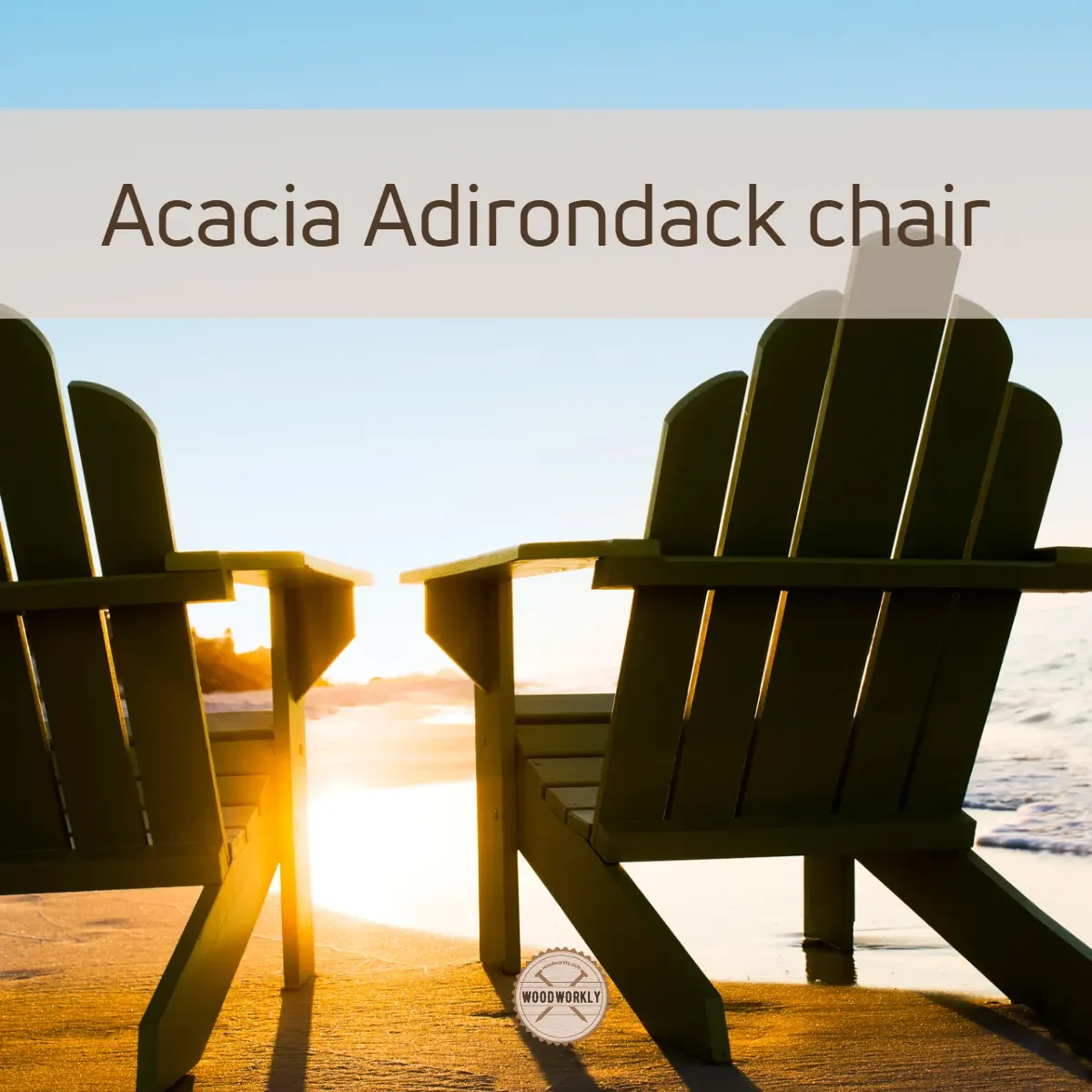
Sustainability
Choosing Acacia wood for your Adirondack chairs not only provides a beautiful and durable material but also supports responsible forestry practices.
The fast growth rate of Acacia trees allows for a quicker replenishment of harvested timber, contributing to a more sustainable future for the woodworking industry and the environment.
Workability
Despite its hardness, Acacia wood responds well to a range of woodworking techniques, including cutting, shaping, and sanding.
This workability allows craftsmen to create intricate designs, patterns, and details on Adirondack chairs, ensuring that each piece is not only functional but also a beautiful work of art that enhances your outdoor space.
When making Adirondack chairs from Acacia wood, these characteristics contribute to the creation of attractive, durable, and eco-friendly furniture that can be enjoyed for years to come, making it an ideal choice for your outdoor projects.
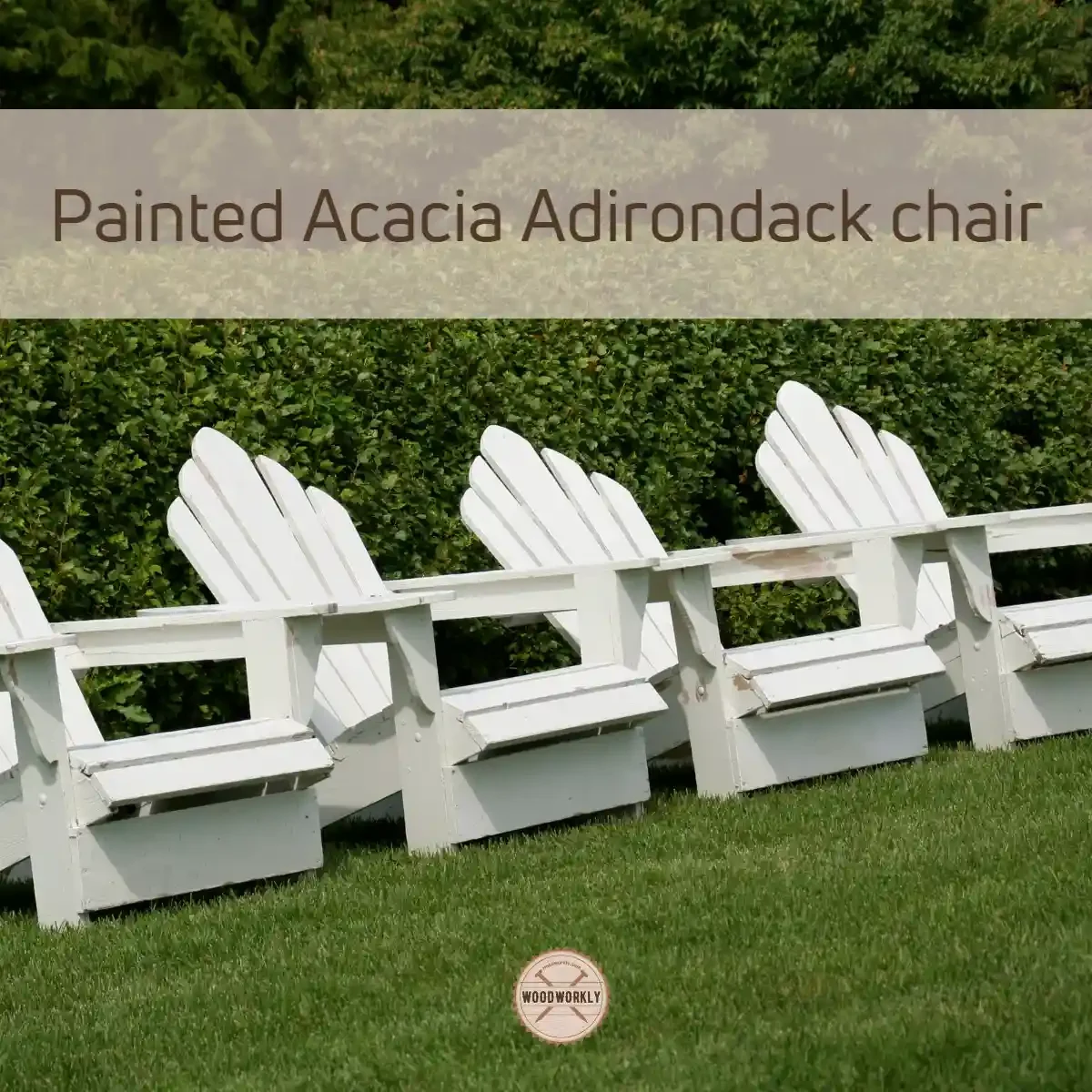
Advantages and Disadvantages Of Using Acacia For Adirondack Chairs
| Advantages | Disadvantages |
| Durable, strong, and resistant to rot and insects | Requires regular maintenance to maintain its appearance |
| Eco-friendly due to its fast-growing nature | Can be heavy and difficult to move |
| Natural oils provide built-in weather resistance | Prone to cracking if not properly treated |
| Generally more affordable compared to teak or ipe | Not as long-lasting as some other hardwoods |
12. Alder
Alder is a strong and dense hardwood with excellent workability. Therefore, it is an ideal choice for making Adirondack chairs.
Since it has a lower rating of hardness which is 590 lbf it is considered a soft hardness.
Therefore, even a beginner in woodworking can easily, cut, shape and nail alder wood without cracking the wood when making projects like Adirondack chairs.
Its appearance resembles birch or cherry wood, and it is sometimes used as a more affordable alternative to these woods.
The smooth texture of Alder wood is often appreciated for its ease of finishing and its consistent color.
Its appearance resembles birch or cherry wood, and it is sometimes used as a more affordable alternative to these woods.
The smooth texture of Alder wood is often appreciated for its ease of finishing and its consistent color.
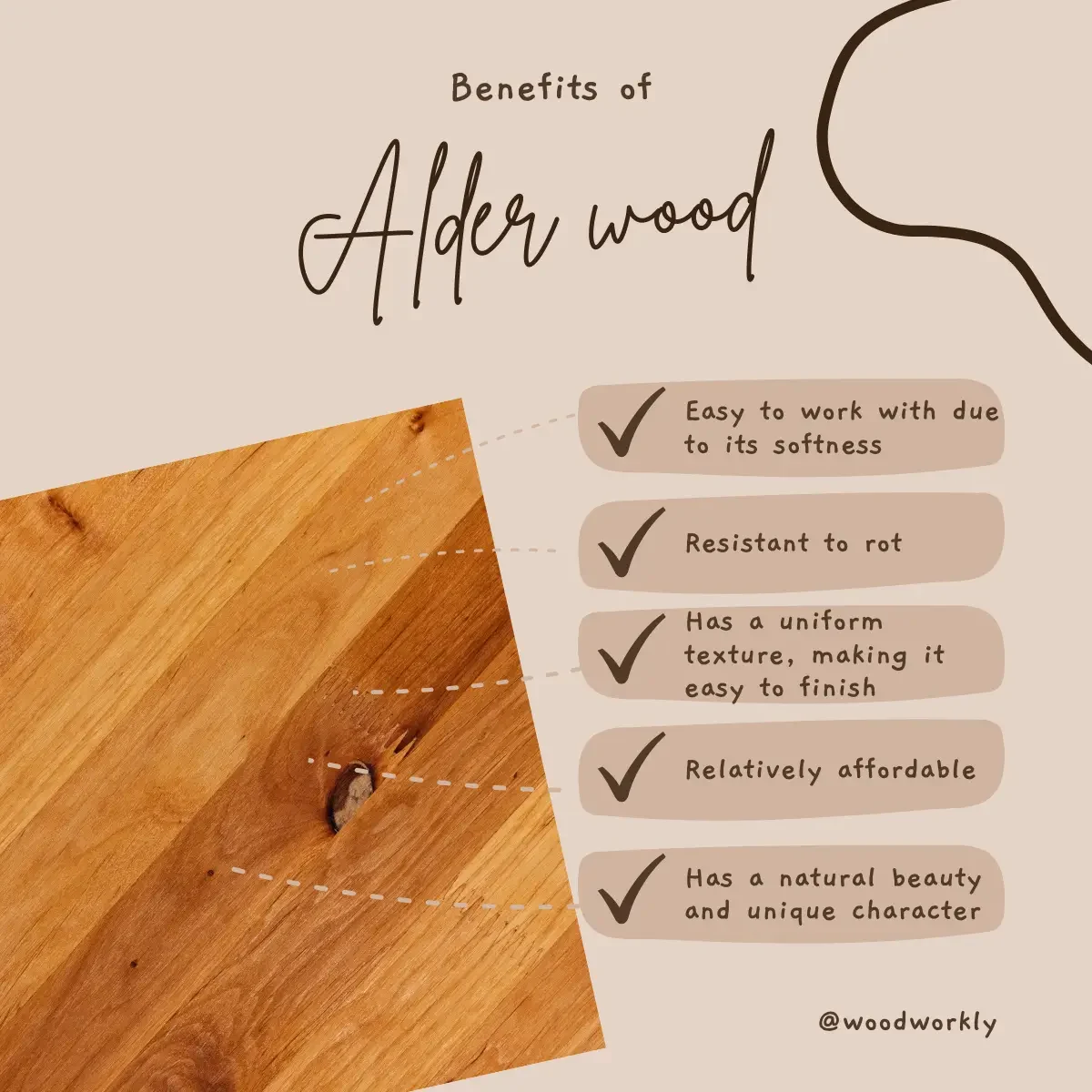
Here’re some characteristic features of alder which make it great for Adirondack chairs,
Workability
Alder’s workability is a boon for woodworkers, as it allows them to achieve precise cuts and shapes with less effort than harder woods.
Its cooperative nature means that even those new to woodworking can craft beautiful Adirondack chairs with less frustration, making it an inviting choice for beginners.
Lightweight
The lightness of Alder wood enhances the portability and maneuverability of your Adirondack chairs.
This attribute is especially valuable for those who enjoy rearranging their outdoor spaces or need to store their furniture when not in use, as it reduces the physical strain of moving heavier chairs.
Affordability
The cost-effectiveness of Alder makes it a popular option among Adirondack chair enthusiasts seeking an attractive yet budget-friendly material.
This allows you to invest in multiple chairs or other matching outdoor furnishings without putting a significant dent in your wallet, creating a cohesive and inviting outdoor space.
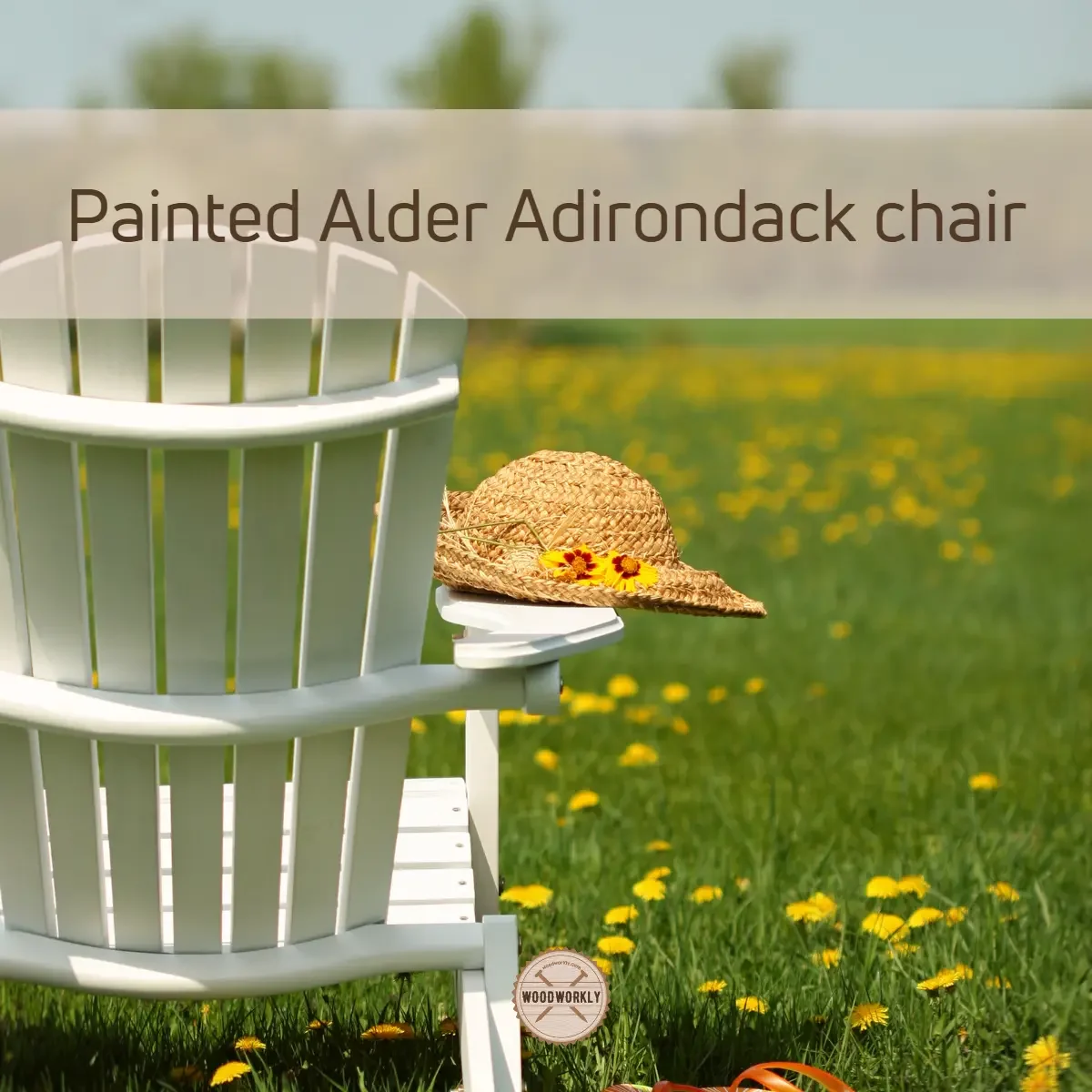
Finishing
The ease of finishing Alder wood is a distinct advantage, as it readily accepts various stains, paints, or clear finishes.
After making the Adirondack chair using alder wood, make sure to finish it with a quality sealer for the long run without getting damaged by moisture, UV light, and other elements.
This versatility enables you to express your creativity and personal style, tailoring your Adirondack chairs to your precise vision and ensuring they complement your outdoor environment.
Sustainability
Choosing a sustainable material like Alder not only promotes environmental responsibility but also contributes to the longevity of the woodworking industry.
As a fast-growing species, Alder offers a renewable resource that helps to support local economies and maintain the availability of quality materials for future generations.
While Alder may not possess the same level of rot and insect resistance as some of the other woods on this list, it can still be an excellent choice for Adirondack chairs when properly finished and maintained.
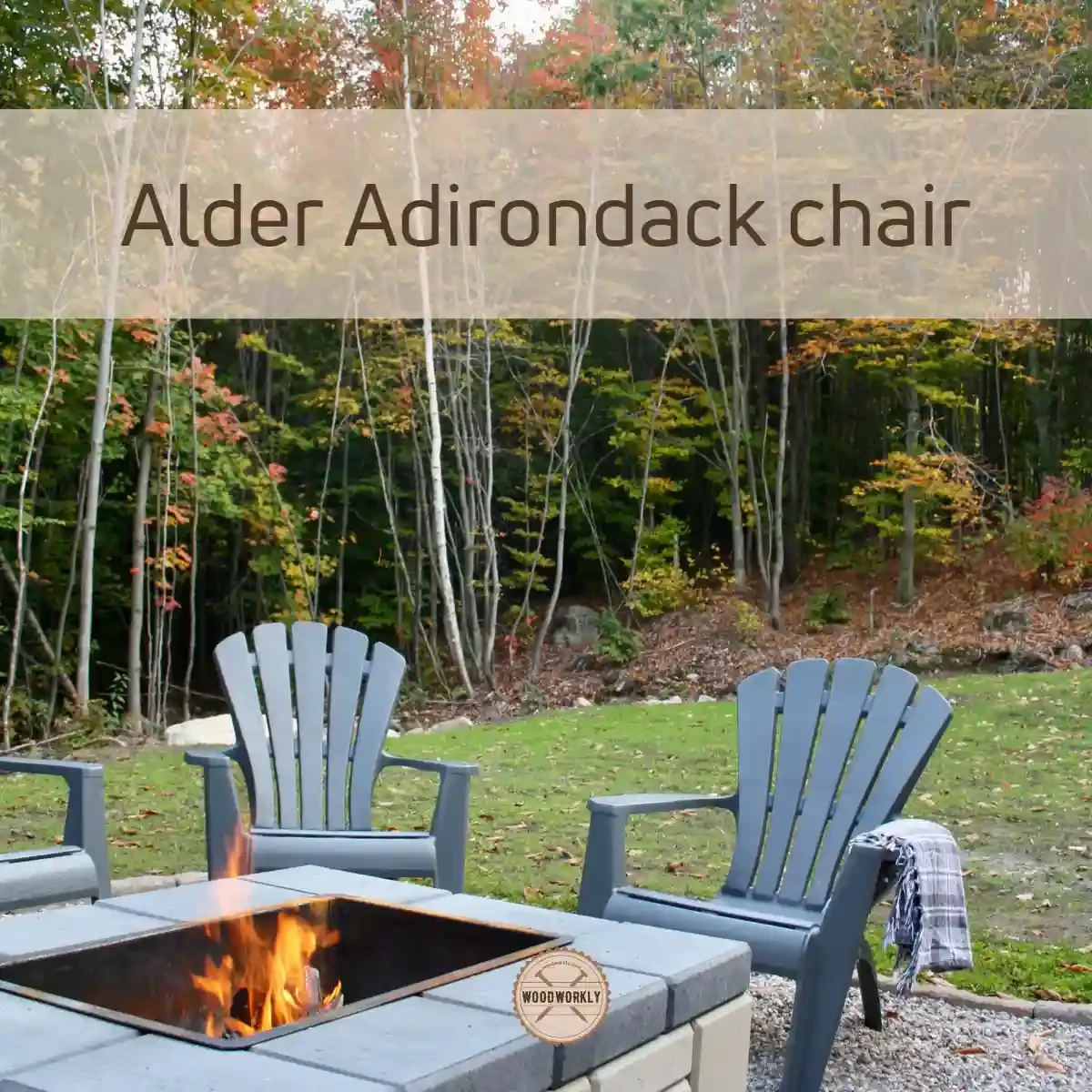
Advantages and Disadvantages Of Using Alder For Adirondack Chairs
| Advantages | Disadvantages |
| Lightweight and easy to work with | Not as durable as other hardwoods |
| Even grain pattern makes for an attractive appearance | Requires regular maintenance to prevent decay |
| Takes stains and finishes well | More susceptible to rot and insect damage |
| Tends to be more affordable than other hardwood options | Not ideal for long-term outdoor exposure |
13. Aspen
Aspen is one of the best woods for Adirondack chairs since it has excellent durability, and strength and aspen wood is easy to finish with any sealer to keep your Adirondack chair protected for so long.
Aspen is softer than many other hardwoods. Therefore, working with aspen is super easy even for a beginner in woodworking.
Its appearance is characterized by a pale, creamy color with subtle, straight-grain patterns.
Aspen wood has a smooth texture and a fine, uniform grain that makes it visually appealing for furniture projects.
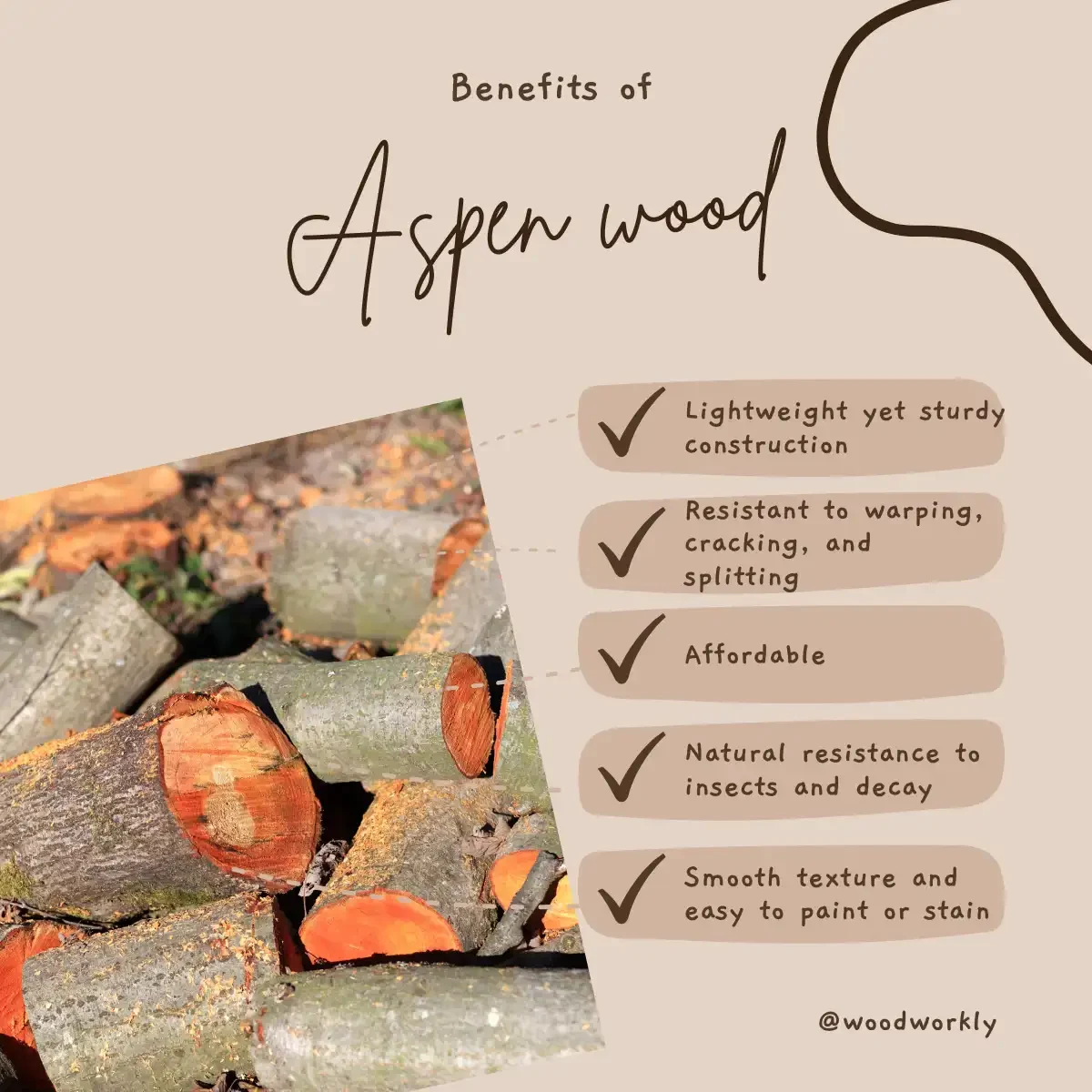
Aspen is considered a great wood for Adirondack chairs due to the following factors:
Lightweight
Aspen’s low density contributes to its lightweight nature, making it easier to handle and transport compared to denser wood species.
This quality makes it possible to lift and move Adirondack chairs effortlessly, whether you’re rearranging your patio or preparing for a gathering.
Workability
The soft and pliable nature of Aspen wood is a boon for woodworkers, as it responds well to cutting, shaping, and sanding.
Its forgiving characteristics make it an excellent choice for beginners, who might find working with harder woods more challenging and time-consuming.
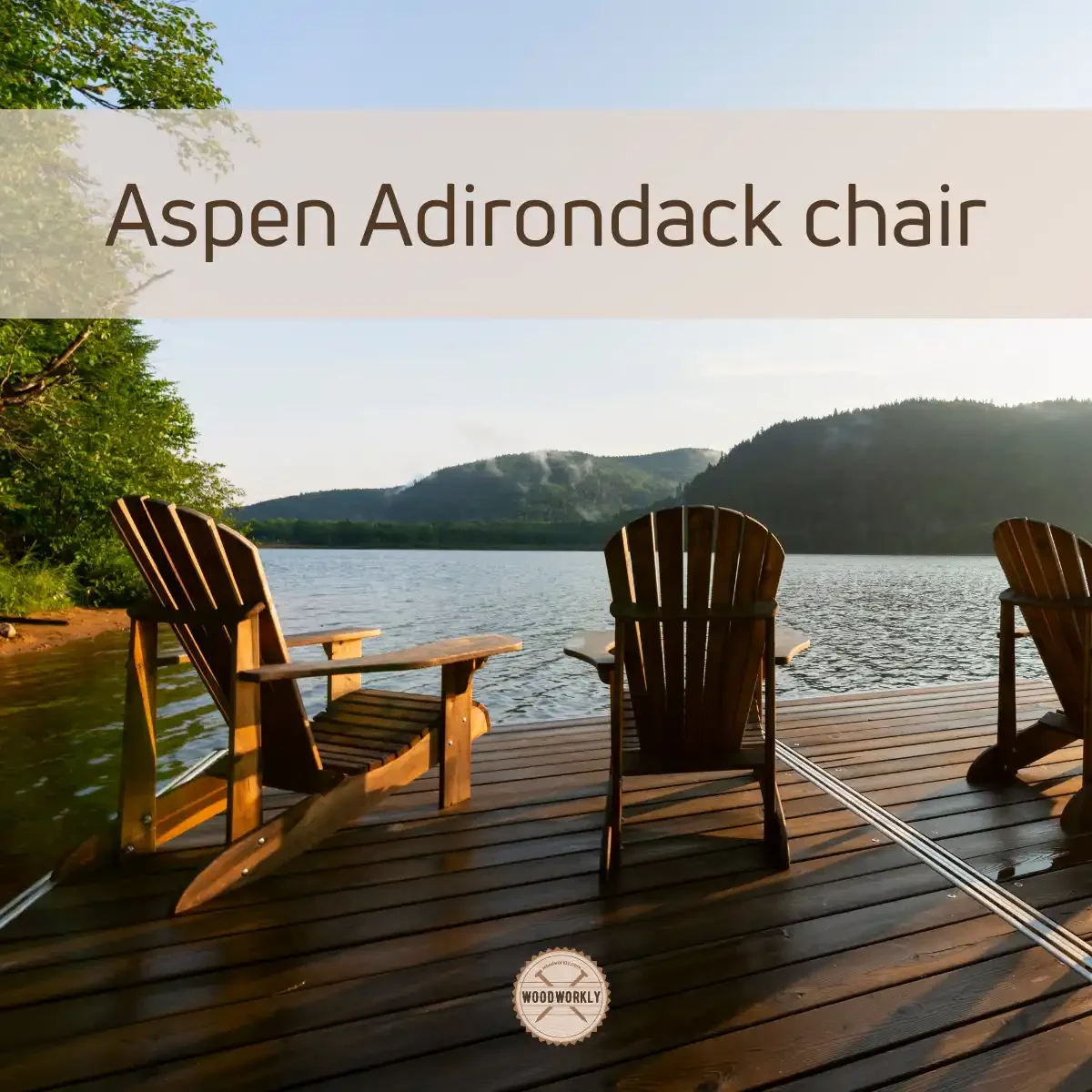
Paintability
The smooth surface and fine grain of Aspen make it a perfect canvas for paint and other finishes.
You can finish aspen wood with any paint or stain you want. It takes paint and stains evenly to make a protective finish with an enhanced wood appearance.
Its ability to absorb paint evenly ensures a consistent and polished appearance, offering a wide range of customization possibilities to suit your personal style or complement your outdoor decor.
Affordability
Aspen’s relatively low cost is an attractive feature for many, as it allows for the creation of beautiful Adirondack chairs without a significant financial investment.
This makes it possible to create a comfortable and inviting outdoor space even on a limited budget.
Eco-friendliness
Aspen’s rapid growth rate means that it is a more sustainable option when compared to slow-growing hardwoods.
By choosing Aspen, you are promoting responsible forestry practices and supporting renewable resources, thereby reducing the environmental impact of your furniture choices.
Keep in mind that Aspen’s lower durability and decay resistance means that proper care and maintenance are vital to ensure your Adirondack chairs enjoy a long, functional life.
Regular application of protective finishes and timely repairs can help to mitigate these concerns and maximize the lifespan of your Aspen Adirondack chairs.
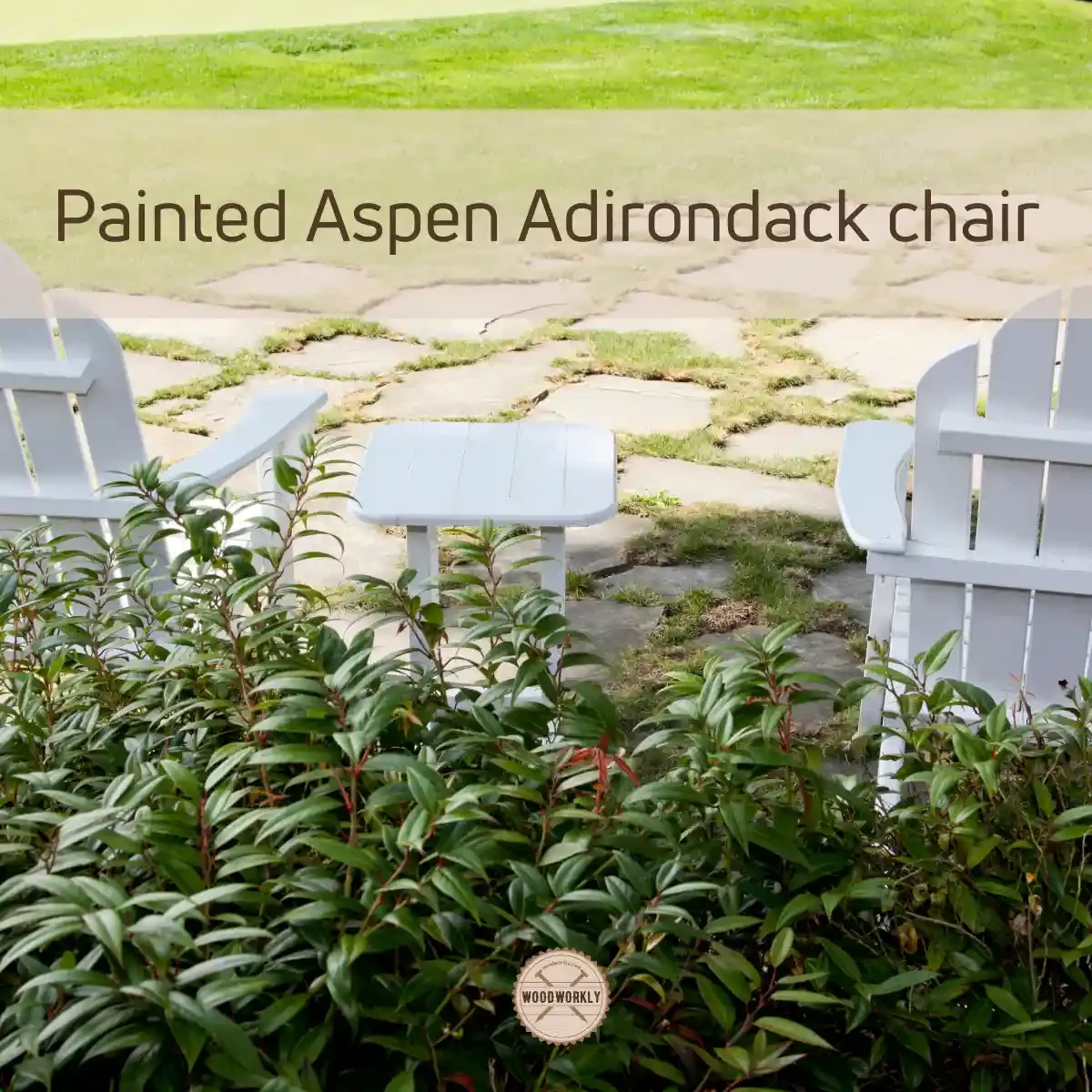
Advantages and Disadvantages Of Using Aspen For Adirondack Chairs
| Advantages | Disadvantages |
| Lightweight and easy to work with | Less durable compared to other hardwoods |
| Accepts stains and finishes well | Requires regular maintenance to prevent decay |
| Affordable and eco-friendly option | More susceptible to rot and insect damage |
| Fine texture and subtle grain pattern | Not the best choice for long-term outdoor exposure |
14. Maple
Maple is a hardwood with a Janka hardness rating of 1,450 lbf (hard maple) and 9650 lbf (soft maple). With proper finishing, you can use maple wood for outdoor applications like making Adirondack chairs without any issues.
Its appearance ranges from creamy white to light reddish-brown, and it may exhibit bird’s-eye, quilted, or curly figure patterns.
Maple wood is used in various applications, including furniture, cabinetry, and flooring, due to its strength and durability.

Maple is considered a suitable wood for Adirondack chairs for several reasons:
Durability
Maple is a durable wood which makes it an ideal choice for making an Adirondack chair.
Maple’s durability arises from its dense structure and tight grain patterns, giving it a robust and long-lasting nature.
This characteristic makes it highly resistant to dents, scratches, and general wear, ensuring that Adirondack chairs built with maple can withstand rigorous use and remain in excellent condition for years to come.
Workability
The ability of maple to be worked into intricate designs stems from its uniform texture and lack of voids or pockets.
These attributes make it easy for woodworkers to achieve clean cuts and smooth edges, allowing them to create visually stunning and comfortable Adirondack chairs with minimal effort.
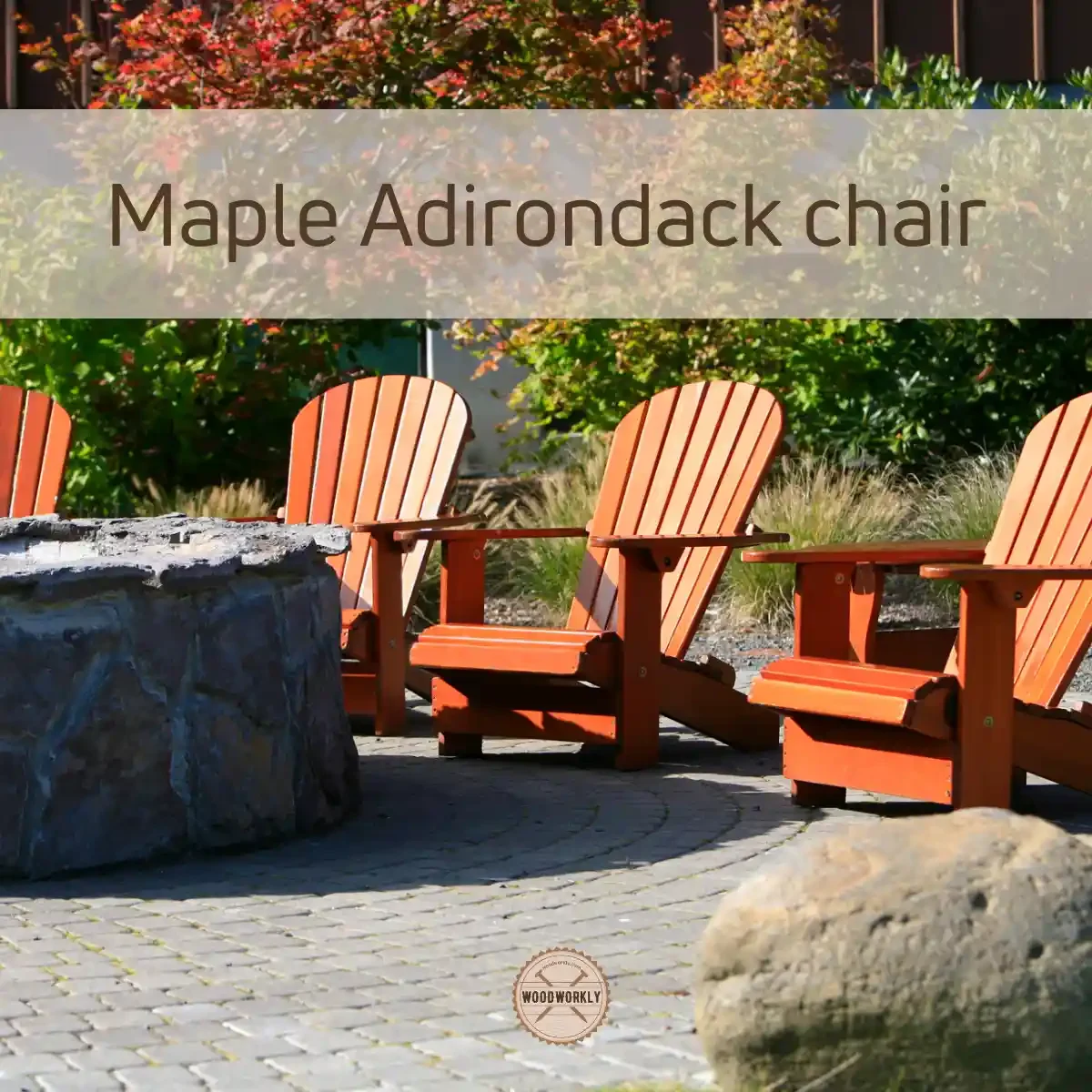
Aesthetic appeal
Maple’s light color palette and subtle grain variations make it an attractive option for those seeking a clean, modern look. Its neutral tones can blend seamlessly with various outdoor settings, creating an inviting and cohesive atmosphere that encourages relaxation and conversation.
Easy to finish
The versatility of maple allows for a broad range of color options when staining or painting, enabling homeowners to create unique pieces that reflect their personal style.
Maple wood takes wood stain and finish evenly and you’ll be able to make a protective coat over maple to use for outdoor projects with an improved wood appearance.
Additionally, maple’s smooth surface makes it easy to apply finishes evenly, ensuring a professional appearance and long-lasting protection.
Stability
The dimensional stability of maple is a result of its low shrinkage rate, which minimizes the risk of warping and twisting.
This characteristic ensures that Adirondack chairs made from maple will maintain their form and functionality throughout changing weather conditions, providing a consistently comfortable and reliable seating option for your outdoor living space.
Please note that, maple wood is not as naturally resistant to decay and insects as some other wood species.
To protect maple Adirondack chairs from the elements, it is necessary to apply a proper finish and maintain it regularly.
With the right care, maple wood can be an excellent choice for crafting Adirondack chairs with style, durability, and comfort in mind.
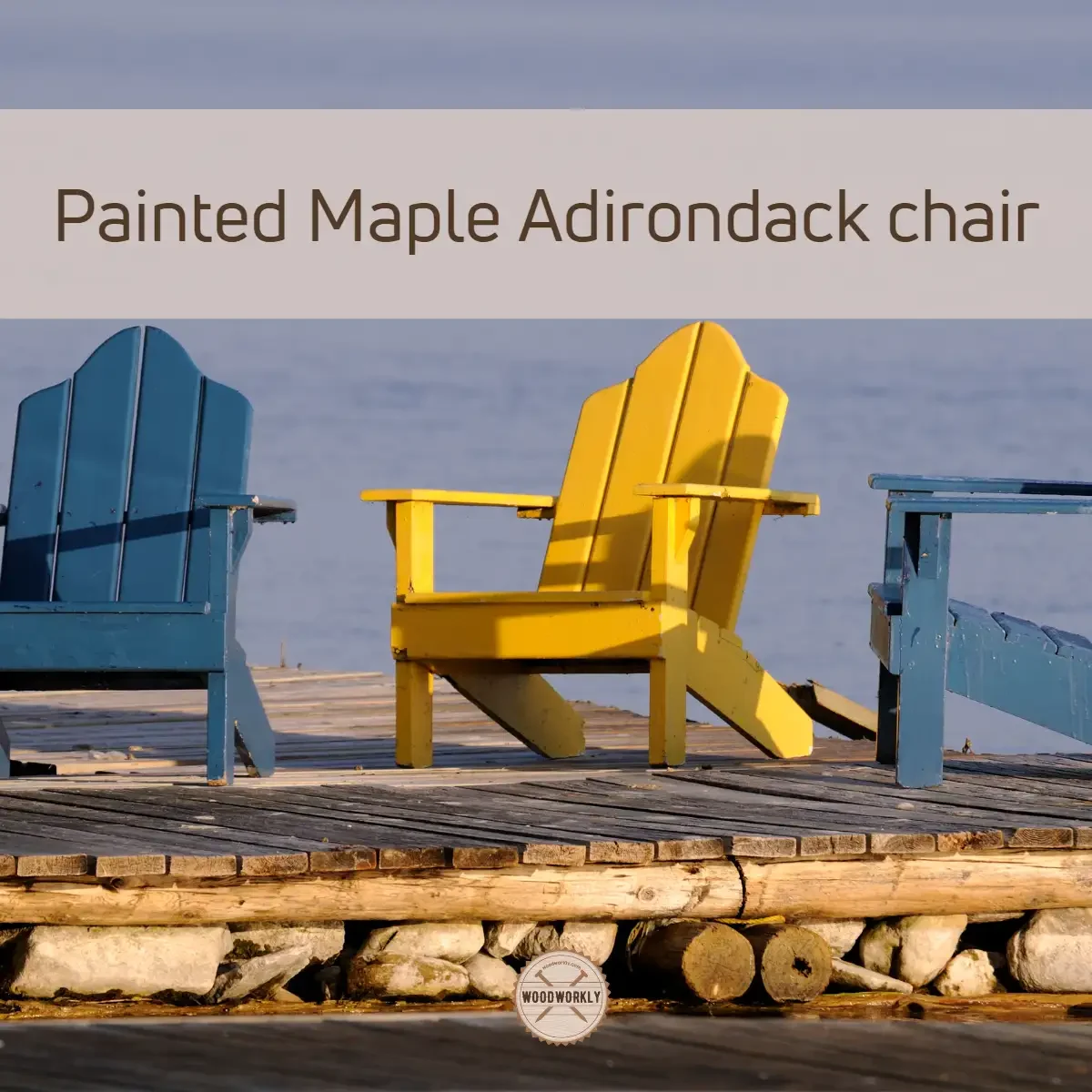
Advantages and Disadvantages Of Using Maple For Adirondack Chairs
| Advantages | Disadvantages |
| Durable and long-lasting | Expensive compared to some other woods |
| Stable and resistant to warping or twisting | Can be difficult to work with due to its hardness |
| Accepts stains and finishes well | May have uneven coloring or grain patterns |
| The attractive wood grain pattern | Heavy and may not be suitable for portability |
| Naturally resists damage from insects and moisture | Not as weather-resistant as some other woods such as teak or cedar |
15. Pressure Treated Wood
Now you know all the best wood for Adirondack chairs under solid wood. But, there’re some pressure-treated woods as well which are useful to make Adirondack wood with excellent durability and strength which last for a long.
Pressure-treated wood has resistance to decay, insects, and fungi which is great for outdoor projects.
It typically has a greenish or yellowish hue, with variations depending on the specific chemicals used in the treatment.
The treatment process leaves the wood with a slightly damp or wet appearance, although it eventually dries out over time.
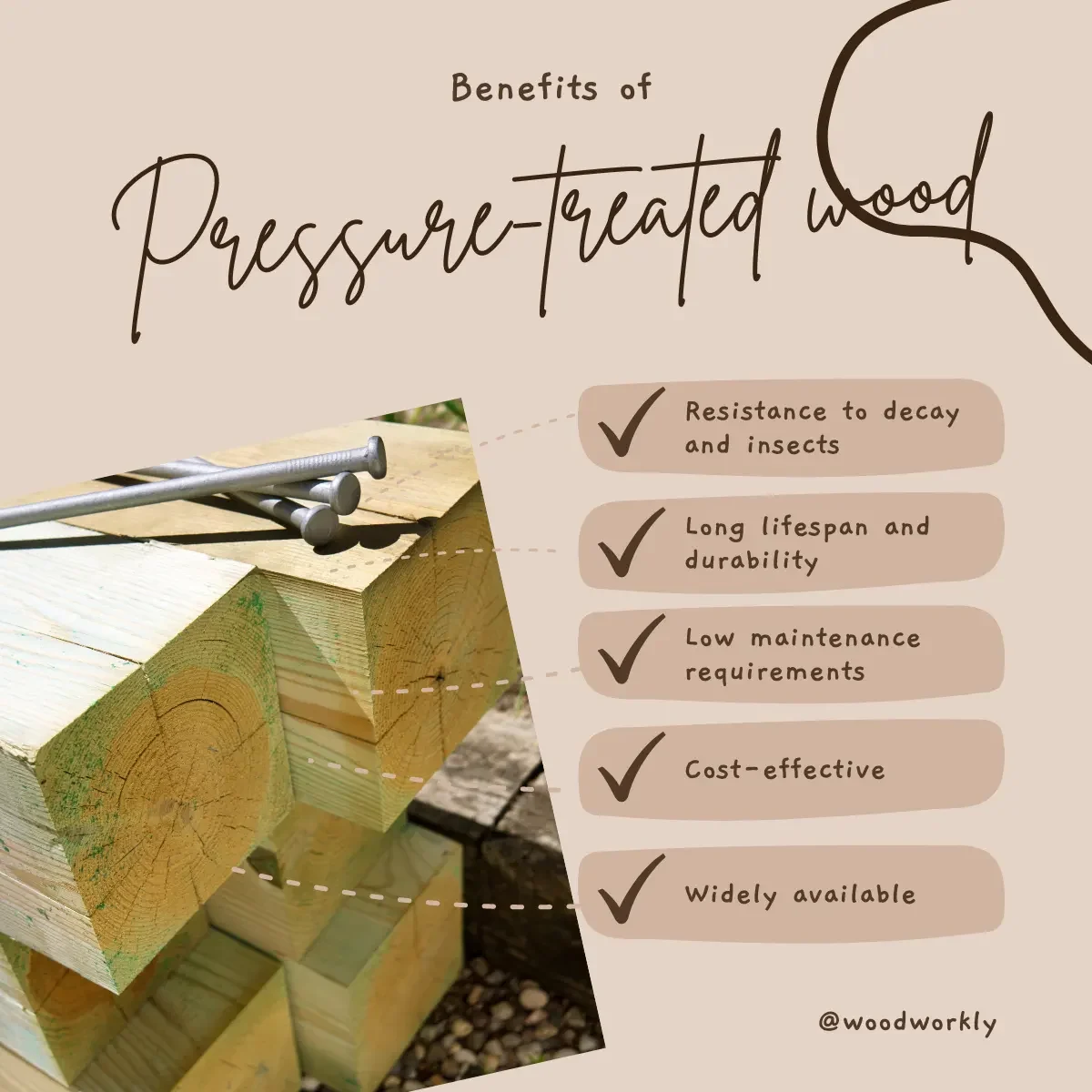
Pressure-treated wood is considered one of the best options for Adirondack chairs due to the following factors:
Resistance to decay and insects
The chemical treatment process utilized in pressure-treated wood involves infusing the lumber with preservatives that penetrate deeply into the wood fibers.
This creates a robust barrier against decay, insects, and fungal attacks, significantly increasing the wood’s lifespan when used for outdoor projects like Adirondack chairs, where exposure to the elements is inevitable.
Affordability
The widespread availability of pressure-treated wood and the relative ease of the treatment process contributes to its cost-effectiveness.
This makes it an attractive option for many people looking to construct or purchase outdoor furniture while adhering to a budget.
However, it’s worth noting that the price can vary depending on the specific type of wood and treatment chemicals used.
Therefore, select the pressure-treated wood that matches your budget when making Adirondack wood, but don’t forget to ask store professionals about the wood that you select to get knowledge about its usage.
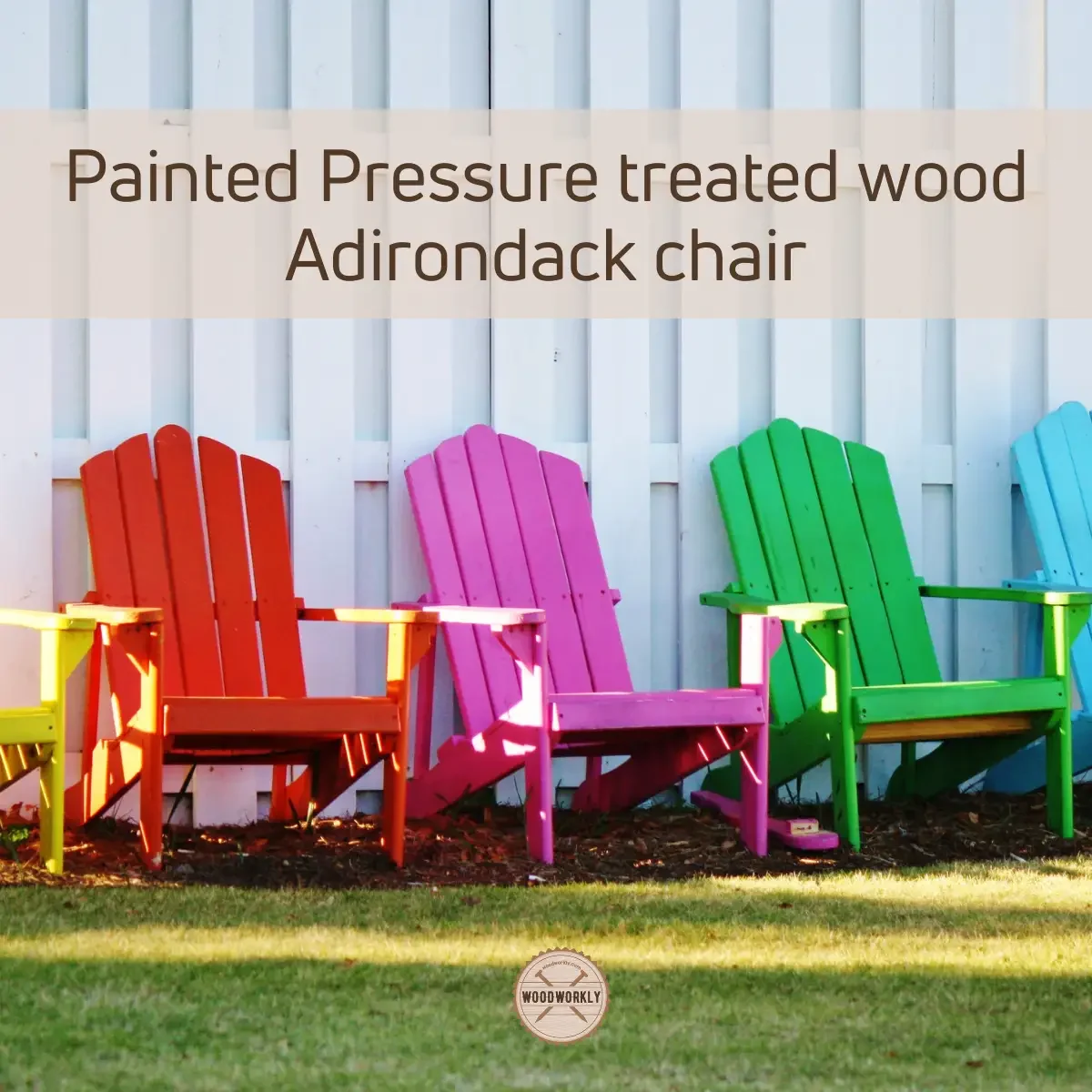
High durability
Pressure-treated wood’s enhanced durability allows it to withstand extreme conditions, including fluctuating temperatures, precipitation, rain, snow, and humidity.
This resilience ensures that Adirondack chairs made from this material can remain functional and visually appealing for an extended period, even when subjected to continuous outdoor exposure.
Low maintenance
As pressure-treated wood is already resistant to decay, insects, and fungi, it doesn’t require the same level of care as untreated wood.
This means that owners can spend less time on maintenance tasks such as applying sealants or addressing insect damage, providing a more carefree experience when using Adirondack chairs made from this material.
Adaptability
Pressure-treated wood’s ability to be painted or stained allows for an array of customization options, catering to individual tastes and preferences.
This flexibility enables homeowners to create a cohesive outdoor aesthetic by matching the color and style of their Adirondack chairs to existing outdoor furniture, decking, or architectural elements.
It is essential to note that pressure-treated wood can have some drawbacks, such as potential chemical leaching and heavier weight compared to untreated wood.
Still, its benefits often outweigh these concerns for those seeking a durable, affordable option for their Adirondack chairs.
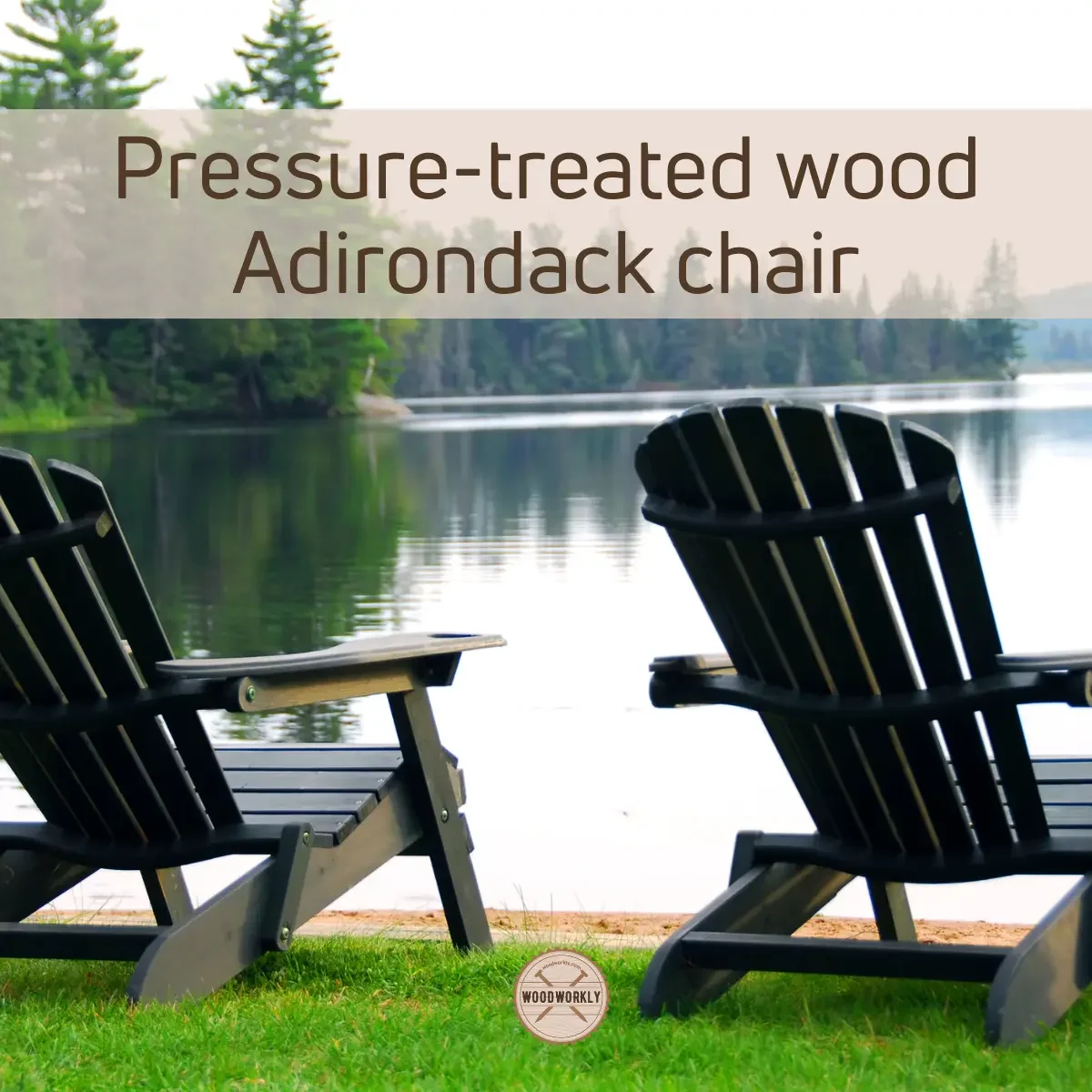
Advantages and Disadvantages Of Using Pressure-Treated Wood For Adirondack Chairs
| Advantages | Disadvantages |
| Durable and long-lasting due to pressure treatment | Contains chemicals that may be harmful to human health and the environment |
| Resistant to rot, decay, and insects | May warp or crack due to exposure to weather and moisture |
| Affordable compared to other woods | Requires regular maintenance and reapplication of sealant or stain to maintain appearance and protection |
That’s it, folks! Now you know the best wood for Adirondack chairs and their characteristic qualities with pros and cons.
Use the knowledge you gained to make a beautiful and strong Adirondack chair and treat them well to use for a long time.
Let’s answer some frequently asked questions as well.
What Are Adirondack Chairs Made Of?
Adirondack chairs are usually made of wood, high-density polyethylene, aluminum, and plastic.
Among them, wood is the best material to make Adirondack chairs use to its aesthetics and high durability.
Make sure to keep your woodworking tools sharp and use quality wood type to make Adirondack chairs finally finish the project with a waterproofing sealer to protect against environmental elements.
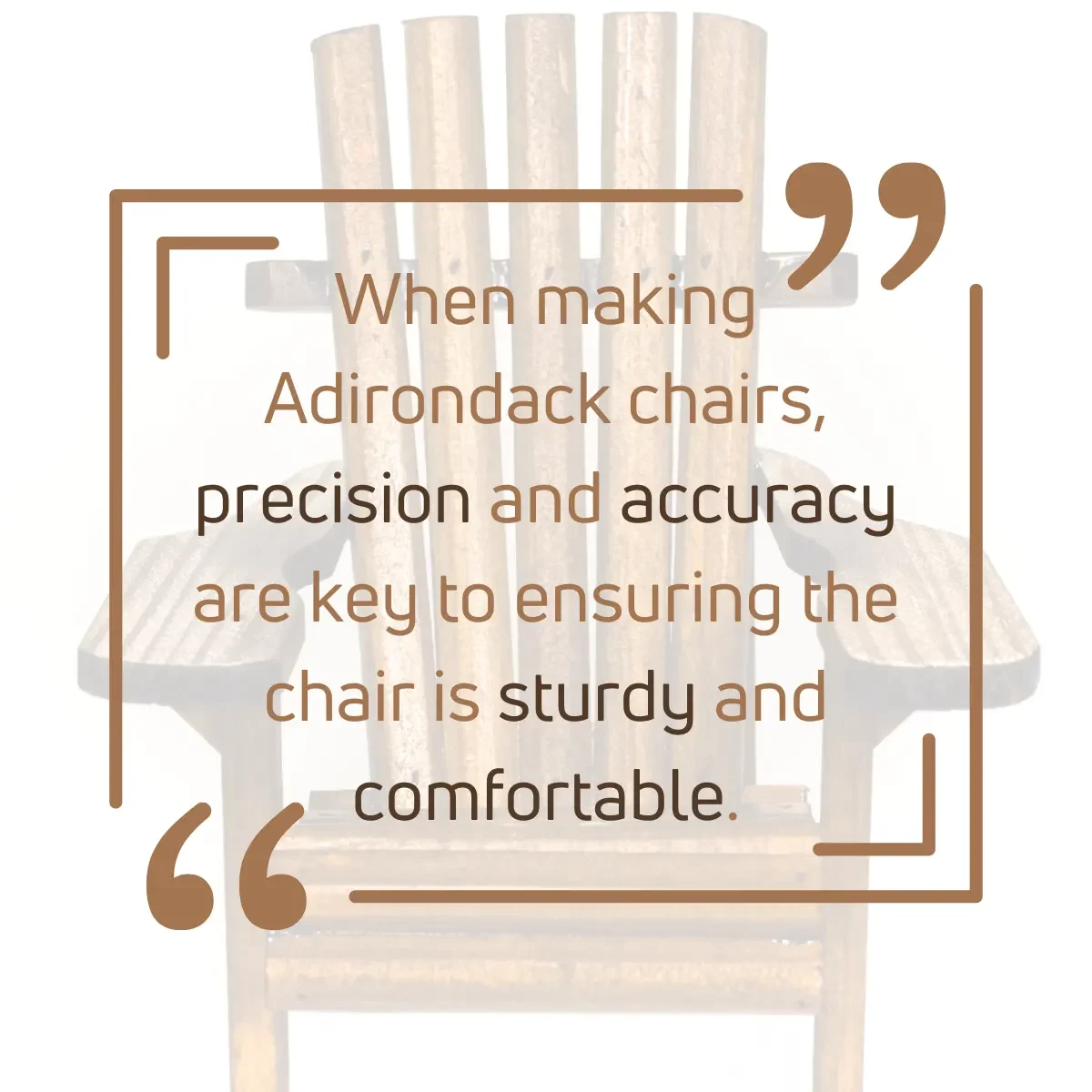
Are Cedar Adirondack Chairs Better Than Teak Ones?
Both cedar and teak are excellent options for Adirondack chairs, but they have distinct differences.
Cedar is less expensive and has natural insect-repellent properties, while teak is more resistant to moisture, decay, and warping.
Teak requires less maintenance and typically lasts longer than cedar, but it’s also more expensive. The choice between the two depends on your budget and desired maintenance level.
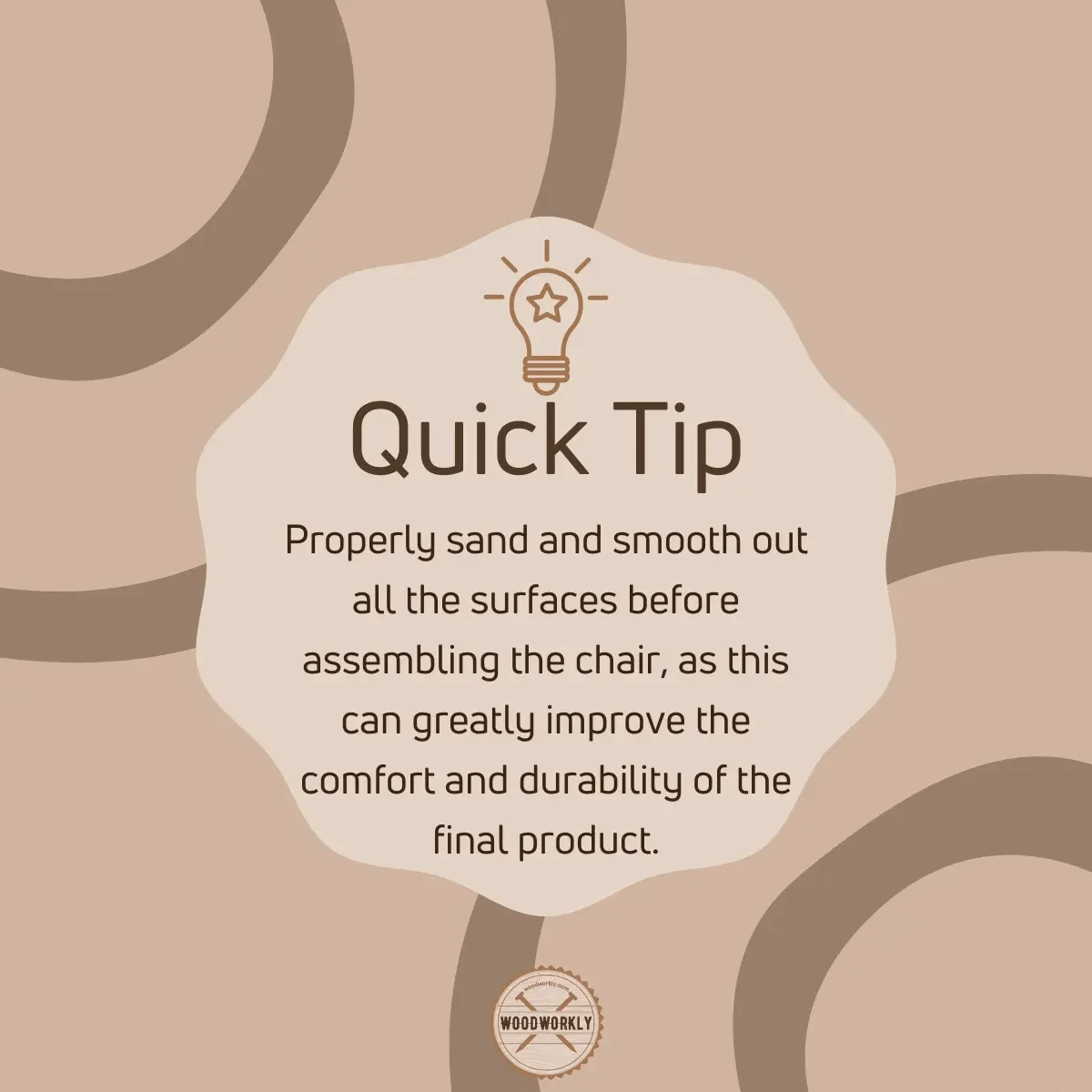
How Long Do Wooden Adirondack Chairs Last?
The lifespan of wooden Adirondack chairs depends on the type of wood, the quality of construction, and the level of care and maintenance.
Generally, high-quality hardwoods like teak, white oak, and ipe can last for several decades with proper care.
Softer woods like cedar, pine, or cypress may have a shorter lifespan, ranging from 10 to 20 years.
Regular maintenance, such as sealing, staining, or painting, can significantly extend the life of your chairs.
Is It Necessary To Seal Or Stain Wooden Adirondack Chairs?
Sealing or staining wooden Adirondack chairs is not always mandatory, but it can help protect the wood from weathering, decay, and insects.
Plus, staining Adirondack chairs help to enhance the wood’s appearance and helps to keep your chair fresh as new for so long.
Some woods, like teak, naturally contain oils that protect them from moisture and decay, while others, like cedar or pressure-treated wood, possess inherent resistance to insects and rot.
However, applying a sealant or stain can further enhance durability, prolonging the life of your chairs and maintaining their appearance.
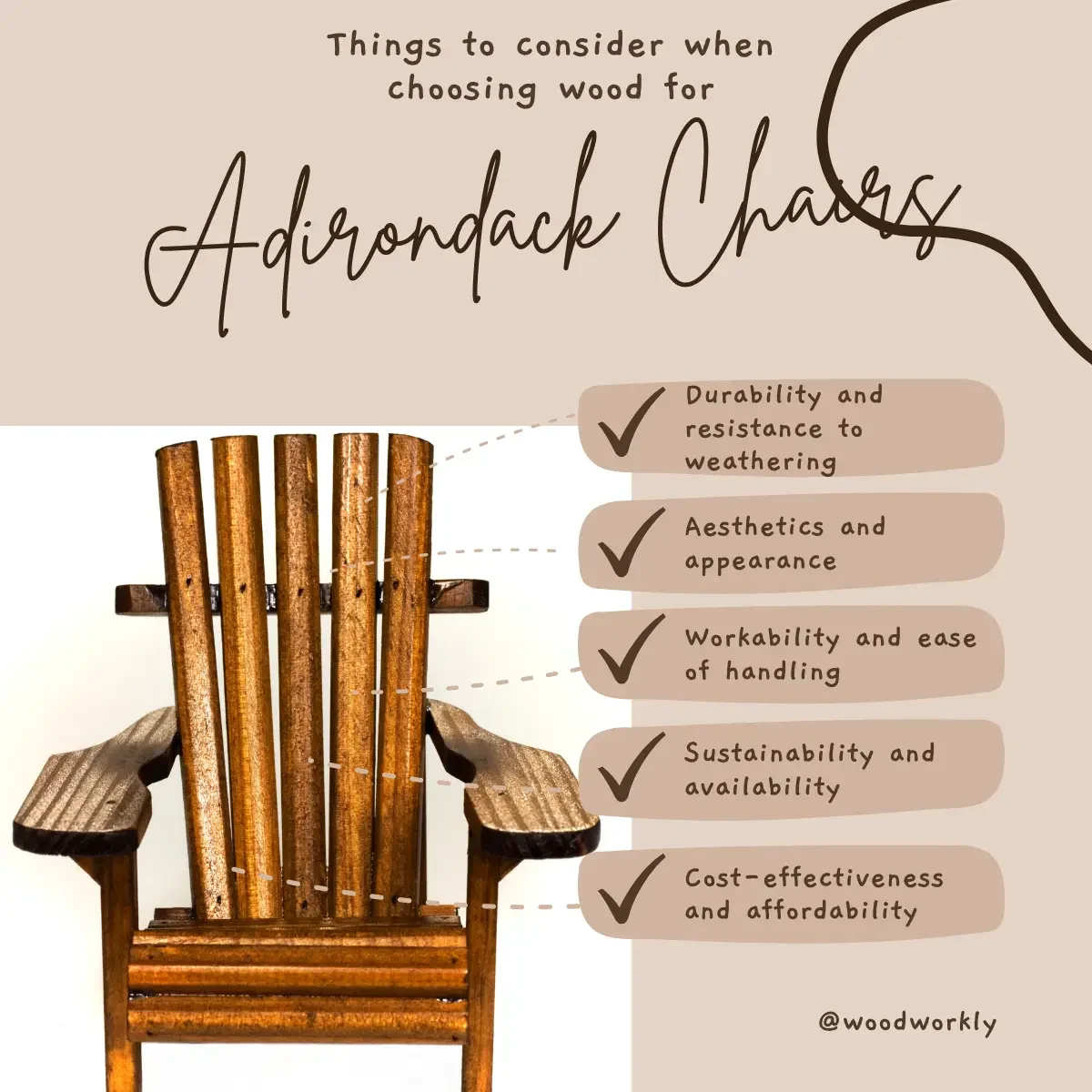
Do Adirondack chairs made from hardwoods require more maintenance than those made from softwoods?
The maintenance requirements for Adirondack chairs largely depend on the specific type of wood, rather than a general categorization of hardwoods and softwoods.
Some hardwoods, like teak and ipe, are low-maintenance due to their natural resistance to moisture, insects, and decay. Conversely, certain softwoods like cedar or cypress might require more frequent sealing or staining to maintain their appearance and durability.
It’s important to research the specific characteristics of the wood you choose to determine the maintenance needs for your Adirondack chairs.
Can I paint my wooden Adirondack chairs instead of staining or sealing them?
Yes, painting wooden Adirondack chairs is an option that provides both protection and a customized appearance.
Painting can shield the wood from moisture, sunlight, and insects while allowing you to choose a specific color or design that matches your outdoor space.
However, keep in mind that paint can chip or peel over time, requiring periodic touch-ups or complete repainting. If you opt for painting, be sure to use high-quality, outdoor-rated paint for the best results and longevity.
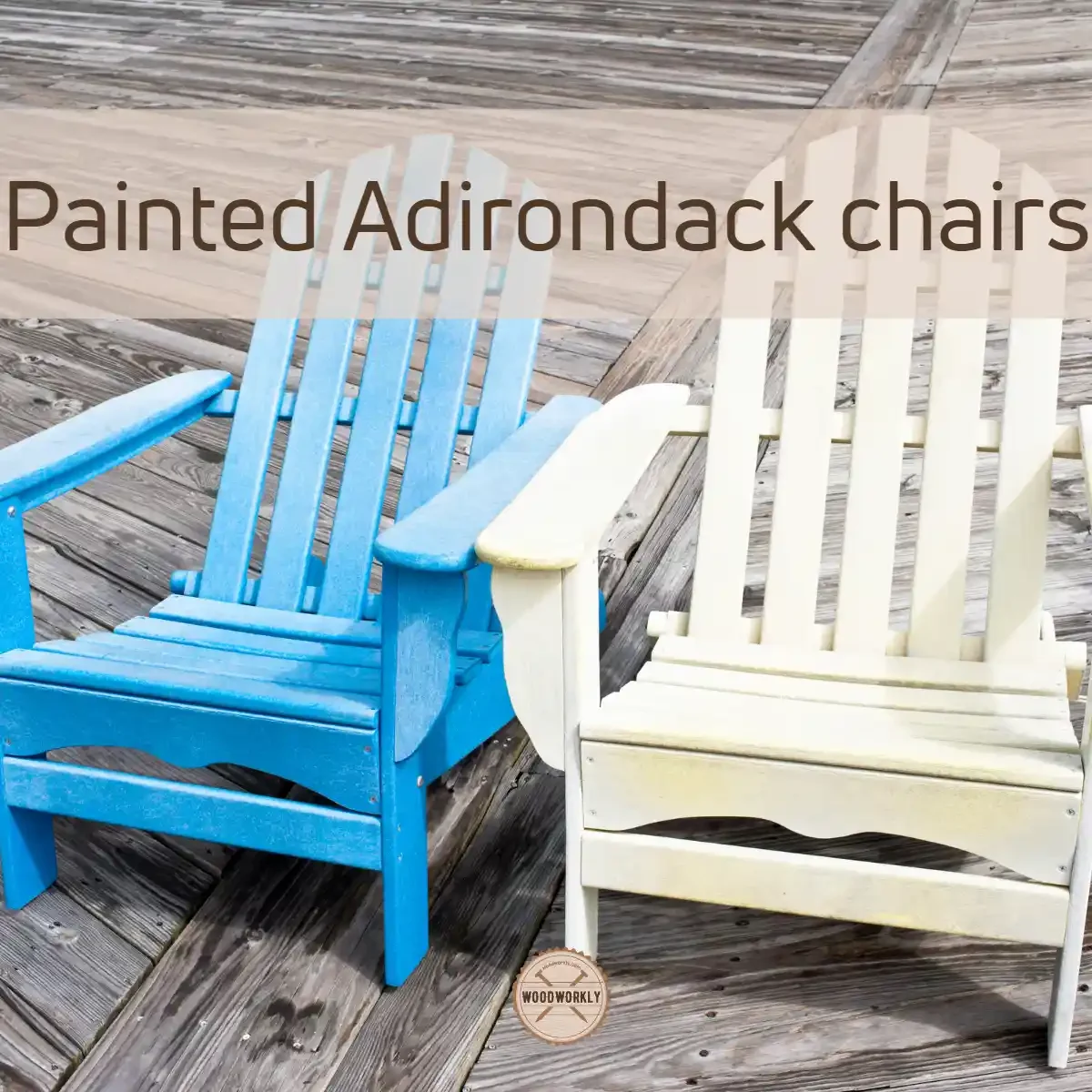
What Are The Best Finish For Wooden Adirondack Chairs?
Here’re some of the best finishes for Adirondack chairs,
- Paint
- Stain
- Clear sealer
- Varnish
- Danish oil
- Tung oil
- Linseed oil
Did I cover all you wanted to know about: Best Wood For Adirondack Chairs
In this article, I’ve explored 15 best wood for Adirondack chairs with characteristic features of each with their pros and cons.
The best wood for Adirondack chairs are red cedar, mahogany, white oak, yellow pine, teak, Ipe wood, red oak, cypress, Douglas fir, eucalyptus, acacia, alder, aspen, maple, and pressure-treated wood. Make sure to sharpen your woodworking tools well before making Adirondack chairs with those woods and finally finish with a quality sealer.
Furthermore, I’ve answered some frequently asked questions as well.
Now, here’s a fun challenge for you: why not dive into the world of DIY and try your hand at crafting your very own Adirondack chair using one of the fantastic woods we’ve discussed?
Just imagine the satisfaction of sitting in a chair that you’ve built with your own hands, knowing you’ve chosen the perfect wood to withstand the test of time.
Happy woodworking, and may your Adirondack chairs be the envy of your neighbors!